THE HOME GUARD
OF GREAT BRITAIN WEBSITE
MEMORIES AND INFORMATION
relating to Home Guard units in
WARWICKSHIRE
This is a page within the www.staffshomeguard.co.uk website. To see full contents, go to SITE MAP.
|
The
most recent addition to this page was on
6th October 2024
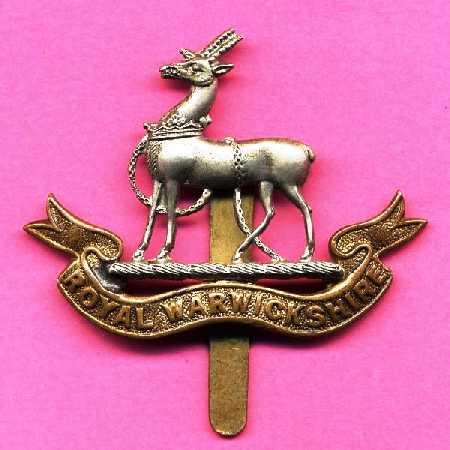 THIS
PAGE includes memories
of and miscellaneous
information
about WARWICKSHIRE
units. THIS
PAGE includes memories
of and miscellaneous
information
about WARWICKSHIRE
units.
(Places
are listed alphabetically and are based on the 1940s
county boundaries).
Similar pages are available elsewhere dealing with
units in
Shropshire, Staffordshire
(including
The 32nd
Staffordshire (Aldridge) Battalion), Worcestershire and
All Other Counties
BIRMINGHAM
(non-specific areas)
|
OVERVIEW - 1940
An
overview of the Home Guard in Birmingham in September 1940 is available
within this website.
It includes messages from the Lord Mayor (himself a Battalion commander) and from the HG Zone Commander; images of early parades; portraits of Battalion C.O.s; mention of Dunlop's pigeon post; and details of Ladywood's own naval force.
************
THE
INITIAL TEN BATTALIONS - 1940
The
initial ten Battalions in September 1940 are listed elsewhere in this website. Their Commanding Officers are identified and images shown.
The
4th Birmingham Battalion,
one of the above initial ten Battalions, is the subject
of
this page. A captioned image of the officers,
possibly photographed in 1940, is shown.
Added March 2015
************
BIRMINGHAM ATTACKED! - 1943
A massive exercise took place over the weekend of 6/7th March 1943 when HG units from Staffordshire and Worcestershire attacked the city from the south and west. The defence of the city was the
responsibility of the Birmingham's own battalions. Around 10,000 men were involved. "Fighting" took place in many areas, the main thrust of the attack concentrating on Harborne and Selly Oak with subsidiary engagements involving street-by-street penetration of the suburbs - all at the same time as a theoretical aerial bombardment of the city. A contemporary description is available.
************
BIRMINGHAM STREET
FIGHTING SCHOOL
Birmingham had its own Street
Fighting School. There are various pages relating to this School providing information about location, individuals, course details (including the script of a play performed by instructors) and the training area off Bristol Street in the area of Ashley, Wrentham, Essex, Gooch and Kent Streets. Links to these pages are provided within the box to the right.
************
POST OFFICE HOME GUARD
The Post
Office Home Guard unit was formed at an early stage. It consisted of
Post Office employees and later evolved into the
47th Warwickshire (Post
Office) Battalion. At least four members of this
Battalion lost their lives in the course of their
service : Vol. George Tibbitts,
aged 42,
of 95 Perry Common Road, Erdington, Vol. Dennis Herbert
Phillips
(see further information under
Sparkhill below),
Squad Leader William Edward
Howkins, aged 23, of Sutton Coldfield
and F.W.T. Charles of
191 Queen's Road, Yardley.
Vol. Phillips and Squad Leader Howkins both died in the same incident when a
direct hit occurred on the unit's guard room at the Post
Office depot during the night of 22nd/23rd November 1940
when the city was subjected to severe bombardment.
A separate
page
of this website describes the tragic circumstances
and also those leading to the death of Vol. Tibbitts and
of Mr. Charles.
*****
Mr.
John Ashmore has provided us with details of less
serious incidents involving this Battalion (although at
the time they were no doubt taken very seriously).
The unit based at Newhall Street (Telephone House)
was the subject of a letter of complaint by Mr. William
A. Bull who worked in the Repeater Station and was also
signed by every other member of that department. (The
list of signatures read like a Who's Who? of Post Office
senior management in the 1970s). It concerned the third
occasion on which a weapon had been discharged from the
yard and this time the shell had ricocheted around the
apparatus room, smashing a lamp. Could the Home Guard be
found somewhere else to do their Rifle Drill, please?
During one night raid, many incendiary bombs were
dropped on the city and some inevitably landed on the
roof of Telephone House. The Post Office staff on the
roof, no doubt including Home Guards, started kicking
them off before they exploded. The owner of a factory
next door wrote a letter of complaint to the Post Office
General Manager complaining about the second-hand bombs
falling on his factory roof...........
************
BIRMINGHAM AUXILIARY
FIRE SERVICE (A.F.S.) HOME GUARD
Information and
images relating to the
35th Warwickshire (Birmingham) Battalion which
consisted of members of the
Birmingham Auxiliary Fire Service (A.F.S.) ; and
of A.F.S. Depot 6/1 which was located in
Washwood Heath.
************
|
BIRMINGHAM CITY TRANSPORT DEPARTMENT HOME GUARD
-
31st and 32nd Warwickshire (Birmingham) Battalions
Birmingham
City Transport Department was one of the first to form a Home Guard unit in the city, to defend its premises and equipment.
(Please see
The initial ten Birmingham battalions). The unit eventually expanded to become the
31st and 32nd Warwickshire (Birmingham) Battalions.
These Battalions consisted entirely of members of the
City Transport Department. They were based at the
various departmental premises throughout the city
and their primary role was to defend and protect
these depots against enemy action of any kind.
A section of this website reproduces
a
detailed commemorative booklet which was
published in January 1945 and, amongst much else
of interest, lists every member of the two
Battalions.
A
further page in this website also gives information on those Battalions and
one or two of the men who served in them.
Pte. Hubert Watkin
was a member of the 31st Battalion. He was based
at Arthur Street,
Small Heath. Information about him
is
here.
************
BIRMINGHAM CITY UTILITIES HOME GUARD
-
29th Warks (B'ham) Battn.
Amongst the
initial ten Birmingham city battalions which
were formed in May/June 1940, the
9th Birmingham
Battalion comprised members of the
various Birmingham Corporation utilities. In
July 1940 it was renamed
29th Warwickshire
(Birmingham) Battalion and retained that
name for the rest of its life. It comprised five
Companies:
"A"
- The Civic
Guard, Council House.
"B" - The Gas Dept.
"C"
- The
Water Dept.
"D"
- The
Salvage Dept.
"E"
- The
Electric Supply Dept
As
was the case with the
31st/32nd Battalions which comprised members
of the city's Transport Department, the
Corporation issued a commemorative booklet after
standdown. This contained much information about
the 29th Battalion's activities and membership.
The entire contents of
"The Birmingham Corporation Home Guard - 29th
Warwickshire (Birmingham) Battalion" appear within this website.
In addition there appears on the appropriate
pages additional information about former
members:
Sgt.
George Chidler ("B" Coy. - Gas Dept.)
Harold Chellingworth,
William Arthur Whitfield, P.A. Ottman, W.H.
Andrews, S. Shaw, A.R. Beesley, A.E.B. Wallis
and T.E.
Thomas (all probably
"E" Coy. -
Electricity)
************
NOTABLE VISITORS
Birmingham had many
Notable Visitors during the war. All of
these visits would have been provided with a
Guard of Honour, manned by members of the city's
Home Guard battalions. The linked page
shows a few of these visits.
|
|
************
OTHER
FACTORY AND UTILITY UNITS
Several Birmingham battalions had specific
responsibility for the various factory or utility units in their
area. There are several examples above: City Utilities,
, Birmingham City Transport Department, A.F.S. and Post
Office. Amongst other similar units were:
-
The 25th Warwickshire (Birmingham) Battalion,
responsible for a group of factories - please see ASTON and
NECHELLS below for further information. An image of
its C.O., Lt.-Col.
S.W.G. Walker and a number of its officers can be
seen here.
-
The
33rd Warwickshire
(Birmingham) Battalion which comprised wholly
employees of the L.M.S. and whose role was to defend all
the premises, equipment and facilities which that
Company owned and operated.
Mark Feeney of 84 Treaford
Lane, Alum Rock
was a member of that Battalion. Read his story and see
his images.
************
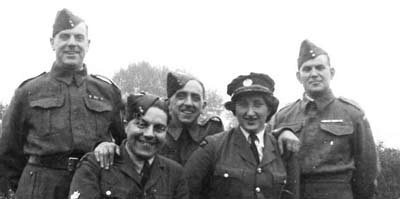
THREE BIRMINGHAM HOME GUARDS
The story of three Birmingham Home Guards from Aston and
Alum Rock, "a Mini-Band of Brothers" who shared much
including family links, Great War and Home Guard service
and deep friendship: Frank
Carter, Mark Feeney
and Arthur Taylor.
************
OTHER BIRMINGHAM WW2
INFORMATION
Memories of Birmingham during WW2, not specifically related to Home Guard activities, are contained within this website:
A Memory of New Street, Winter 1942/1943
A Luftwaffe View of Birmingham, November
The
Birmingham History Webring forums contain a wealth of information and reminiscence about Birmingham during WW2. Use the index or the search facility on the site to find particular aspects.
Another excellent resource is Matt Felkin's
"Wartime
Birmingham and the Blitz"
Facebook page.
OTHER INFORMATION
about the Birmingham Home Guard
(non-specific areas)
|
- A short history of Home Guard activities in Birmingham may be seen
here. (You will leave this site).
************
- In the Wolverhampton Borough Cemetery there is a memorial to:
Denham, Alfred Albert, Sergeant, 6th Warwickshire (BSA Birmingham) Bn. Home Guard. Husband of Katie Winifred Denham, of Springfields, Wolverhampton. Died - 12 January, 1941. Aged - 31.
************
- In the
King's Birthday
Honours of 1941 is included the name of
Capt. F.R.B. Whitehouse
who was awarded the M.B.E. for his services to the
Home Guard. Capt. Whitehouse was Field Engineer Officer
for the Birmingham Zone of the Home Guard.
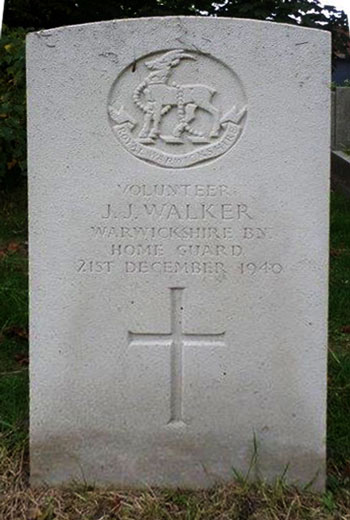
************
- Vol. John James Walker
of an unknown Birmingham Battalion died on December
21st, 1940. His grave is in Witton Cemetery.
Information about the circumstances of this
unfortunate Home Guard's death can be read
here.
(see
right - grateful acknowledgement to Maggie Laity and
Matt Felkin).
- Mr. Frederick Jones,
member of another unknown Birmingham unit recalls:
"......When I was in Dad’s Army — you know, the Home Guard - they gave me a Browning automatic. It was slightly larger than other rifles. You had to hold it like that … it was gas operated: a gas cylinder would propel the bullet then return and move the next one into position … the empty cases were sent up and over your head … hell of a thing it was … I fired Springfields, Winchesters, Gud knows what else......
©
Frederick Jones 2005 (From the BBC People's War archive
ww.bbc.co.uk/ww2peopleswar.)
************
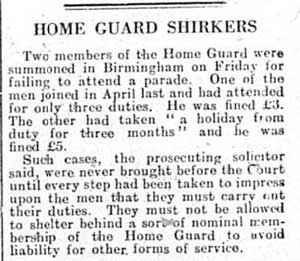 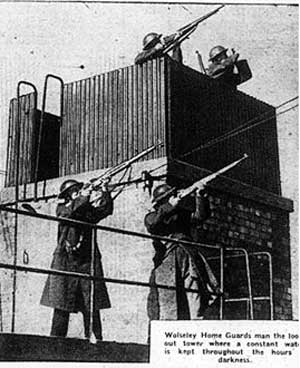
The unit of which
Col. Danielsen took command
is unknown. (Date: post-February
1941)
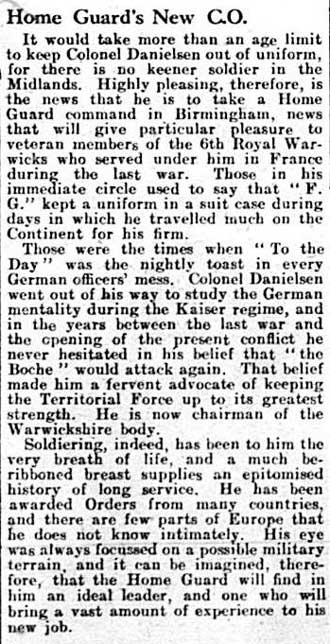
|
|
|
The following
press cutting describes a major exercise
which took place on Saturday and Sunday,
6/7th March 1943.
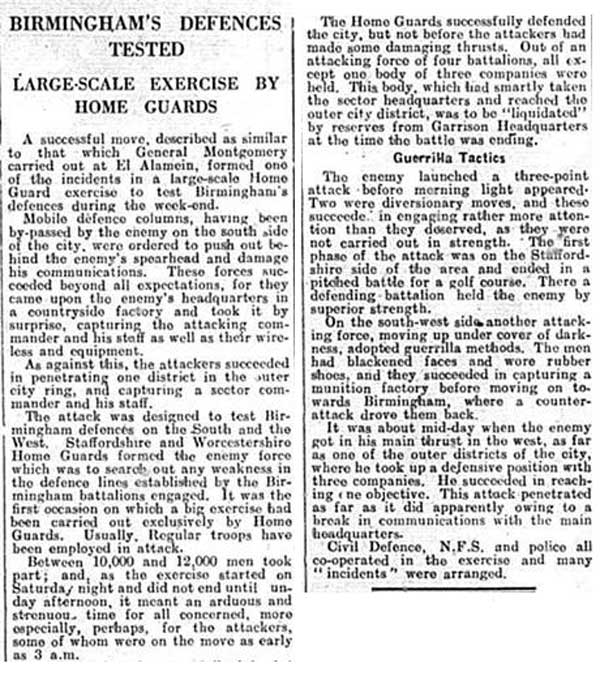
Possibly the Home
Guard, possibly Army troops, involved in bomb damage clearance
in an unknown Birmingham street, 1940 or
1941.

An
unidentified Birmingham
Home Guard unit, perhaps one Company
within a Battalion.
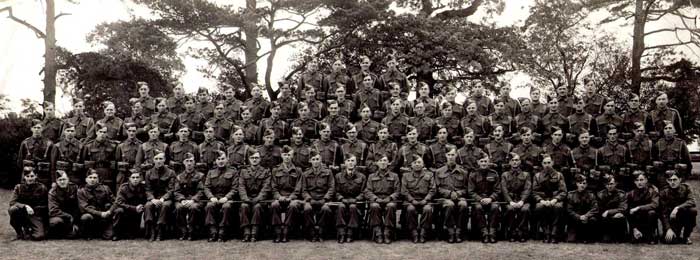
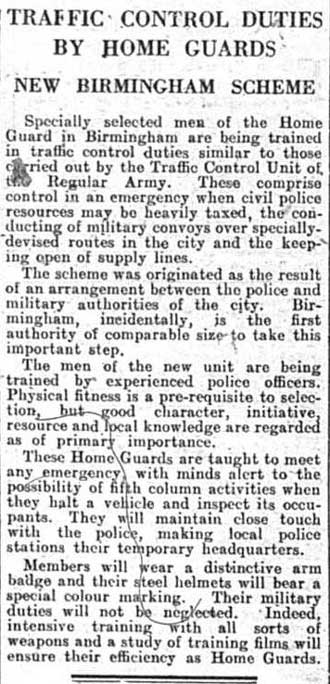
|
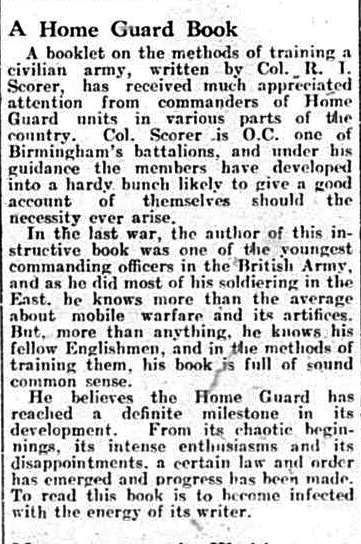
From June 1942......The author of this book, Lt.-Col. R.I.
Scorer, commanded one of the initial ten
Birmingham battalions - the
10th Birmingham Battalion
which evolved in early 1941 into the
30th
Warwickshire (Birmingham) Battalion
which
he continued to command.
Use
Search
to find other references to this officer
within the website. |
From
1941...
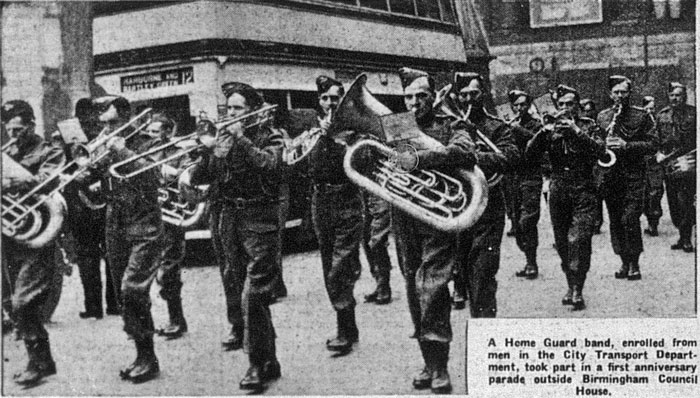
|
|
******************************************************************
BIRMINGHAM
(specific areas)
|
BIRMINGHAM, ACOCKS GREEN
Please see
BIRMINGHAM, ROBIN HOOD below.
******************************************************************
BIRMINGHAM, ASHTED
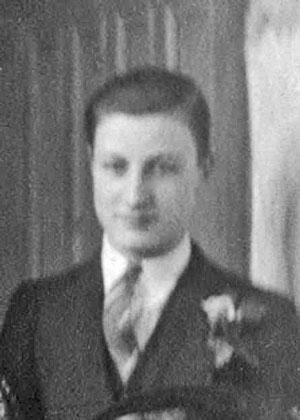
Two closely related families lived close to each
other in Henry Street,
Ashted, and each lost young sons during the
war: Robert Bernard Silk
(Home Guard), William
Silk (Royal Navy) and a further
William Silk, a
first cousin. Robert was 17 when he died in October
1940, having been injured whilst on duty as a member
of 30th Warwickshire
(Birmingham) Battalion, Home Guard. He is
commemorated, together with his elder brother and
his cousin, on
this page of the website.
***********
The Ministry of Labour and National Service in Staniforth Street enquires of
Messrs. Fellows & Darby Ltd. of Snow Hill whether they wish to make any representation concerning the imminent conscription of their employee,
Mr. A. Terry of Ashted, into the Home Guard.
******************************************************************
BIRMINGHAM, ASTON
(see also ERDINGTON, HOCKLEY and NECHELLS below)
The story of Aston Home Guard's two heroes,
Section Leader Alfred Henry George Brunges and
Patrol Leader Charles William Lovelace Tozer
of the
22nd Warwickshire (Birmingham) Battalion who won the George Medal for their bravery on the night of October 26th 1940.
***********
Pte. Joseph Bennett
joined the
22nd Warwickshire (Birmingham) Battalion - which had responsibility for areas of Hockley and Aston - in
December 1940
at the age of fourteen-and-a-half and served until stand-down.
Click
here to read his story.
The same page
also contains information about another
Battalion member,
Sgt. Francis
Goodenough of "B"
Coy.
***********
All the officers, warrant
officers and N.C.O.s of the
22nd Warwickshire (Birmingham) Battalion
were photographed in October 1944
at the
Wesleyan
Theological College
in
Friars Road,
Handsworth (later
Hamstead Hall).
A high definition version of this image is
available to view here.
***********
Mr. Arthur Musson
remembers his Home Guard service with the Hercules factory unit, part of "D" Coy. of the
25th Warwickshire (Birmingham) Battalion.
An image of the Battalion C.O.,
Lt.-Col. S.W.G.
Walker, and a number of its officers can
be seen
here.
************
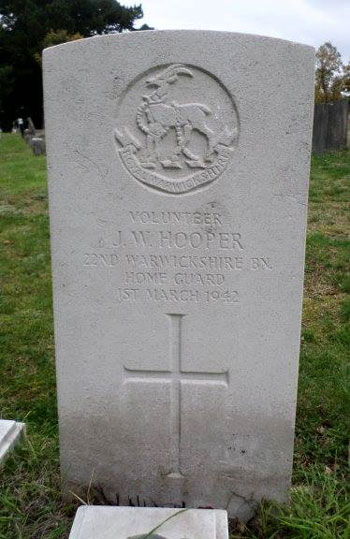 A contemporary account of an air raid on Aston, on an unknown date and involving Albert, Frederick and Victoria Roads, with which various named members of the
23rd Warwickshire (Birmingham) Battalion were closely concerned. A contemporary account of an air raid on Aston, on an unknown date and involving Albert, Frederick and Victoria Roads, with which various named members of the
23rd Warwickshire (Birmingham) Battalion were closely concerned.
************
The headstone
(right) of
Volunteer J.W. Hooper
of the 22nd
Warwickshire Battn. in Witton Cemetery.
He died on 1st March 1942 at a hospital in
Shifnal, Shropshire.
Grateful acknowledgement to
Maggie
Laity and Matt
Felkin and his "Wartime
Birmingham and the Blitz" Facebook page.
************
There is a fascinating film clip
here showing "D" Coy. of the
23rd Warwickshire (Birmingham) Battalion parading in Trinity Road and Aston Park. Many individuals are clearly visible and recognisable.
(You will leave this site).
************
See also Edgbaston below.
************
The
Astonbrook-through-Astonmanor website contains a number of interesting memories of wartime Aston.
(You will leave this site).
******************************************************************
BIRMINGHAM, BORDESLEY GREEN
(see also ACOCKS GREEN,
STECHFORD
and YARDLEY)
Here is information on
Sgt. Jim Baker of Fordrough Lane and the Bordesley Green Home Guard unit of which he was a member, "B" Coy. of the
39th Warwickshire (Birmingham) Battalion.
And reminiscences and images from another member of the same unit,
Pte. Geoffrey Bennett including the night when he and his section overran Elmdon Airport!
******************************************************************
BIRMINGHAM, BOURNVILLE
The Cadburys
factory unit in this area of Birmingham was "B"
Company of the 27th Warwickshire (Birmingham)
Battalion. 1941 images of that unit can be seen
here.
(Please see also
BIRMINGHAM, KING'S NORTON below).
******************************************************************
BIRMINGHAM, CASTLE BROMWICH
Information on the Nuffield Spitfire factory, its Home Guard unit and
Edward Johnson who was active in both, can be seen
here.
Two other employees and members
of the factory HG unit were
Cpl. George Ronald (Ron) Barton
(also
a trainer of Air Cadets) and
Alfred Cartwright;
their story is told on
a further page of this website.
******************************************************************
BIRMINGHAM, CENTRAL
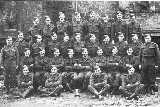 Click on the thumbnail to see an image of the factory Home Guard unit of J. B. Brooks & Co. Ltd. (J.B. Brooks's factories, which were subject to incendiary attack, were located in the area of Great Charles St., Livery St., Ludgate Hill and Lionel St. Their products included bicycle and motorcycle saddles and the Antler range of travel goods. Their wartime products included parachutes and harnesses). Click on the thumbnail to see an image of the factory Home Guard unit of J. B. Brooks & Co. Ltd. (J.B. Brooks's factories, which were subject to incendiary attack, were located in the area of Great Charles St., Livery St., Ludgate Hill and Lionel St. Their products included bicycle and motorcycle saddles and the Antler range of travel goods. Their wartime products included parachutes and harnesses).
**********
The
45th
Warwickshire (Birmingham) Battalion
may have been responsible for the centre of
Birmingham. Here is a press photograph image
of the Battalion parading in the city on
Sunday 13th December 1942 which appeared in
the Evening Despatch a day or two later.

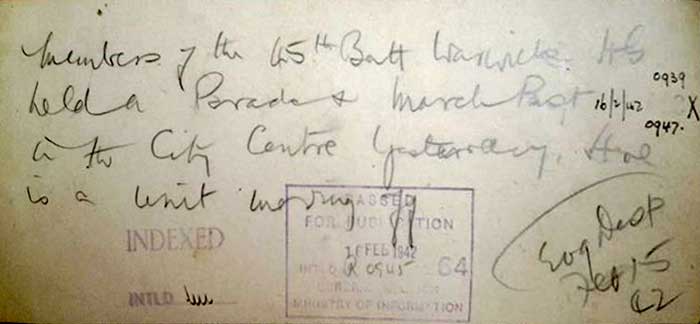
The following image shows another parade in
the city centre: this one occurred on Sunday,
23rd March 1941. It shows a Drumhead Service,
held on the Municipal Car Park, arranged by the
Chaplain, the Archdeacon of Aston. This was followed
by a march-past outside the Council House with the
G.O.C. Western Command, General Sir Robert
Gordon-Finlayson, taking the salute.
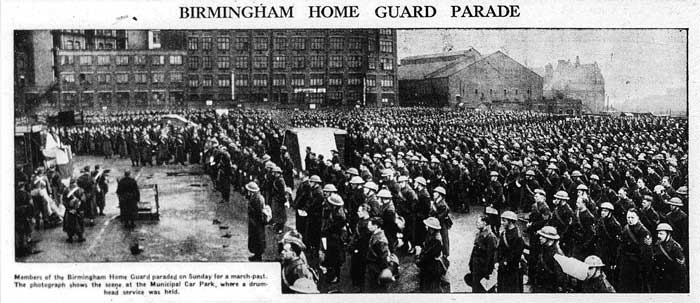
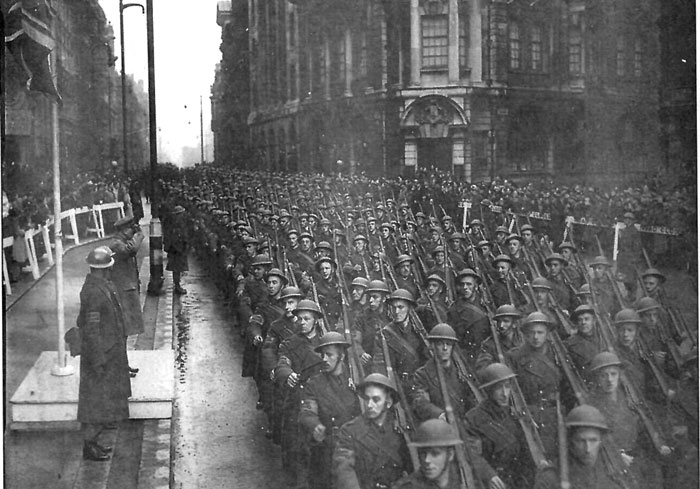
Grateful acknowledgement to
Sue
Birtles;
Birmingham History Forum; and Matt
Felkin and his "Wartime
Birmingham and the Blitz" Facebook page.
**********
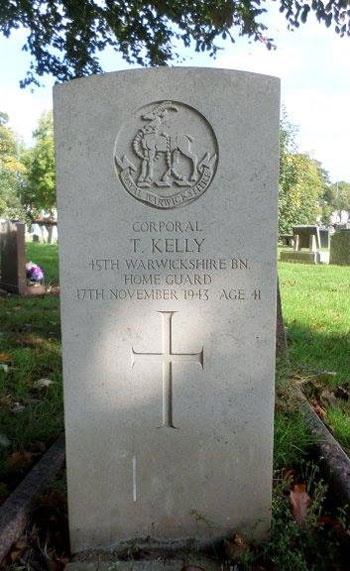 The headstone of Corporal T. Kelly
of the 45th Warwickshire Battn. who died on
17th November 1943. The headstone of Corporal T. Kelly
of the 45th Warwickshire Battn. who died on
17th November 1943.
The circumstances
surrounding Cpl. Kelly's death are unknown but the fact of
his having a C.W.G.C. headstone suggests that his
death was associated with his Home Guard service. It
is possible that the newspaper cutting
(below) from
January 1943 is relevant but at present there is no
means of knowing whether these two T. Kellys are one
and the same man; nor whether the reported accident
had such dire consequences 10 months later.
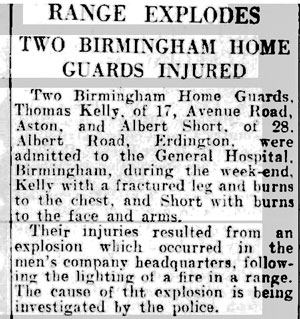
Grateful acknowledgement to
Maggie
Laity and Matt
Felkin and his "Wartime
Birmingham and the Blitz" Facebook page.
******************************************************************
BIRMINGHAM, DERITEND
The linked page stands in memory of the victims of the Bishop Street bombing of the night of 15th/16th October 1940 and in particular the heroism of
Section Leader George Walter Inwood of the
10th Warwickshire (Birmingham) Battalion Home Guard for which he received a posthumous George Cross. There were many other acts of great bravery on that dreadful night from a number of people including Messrs
Tidball (HG),
Wade
(Police),
Woodland, Rainbow
and
Pickersgill (all ARP).
******************************************************************
BIRMINGHAM, EDGBASTON
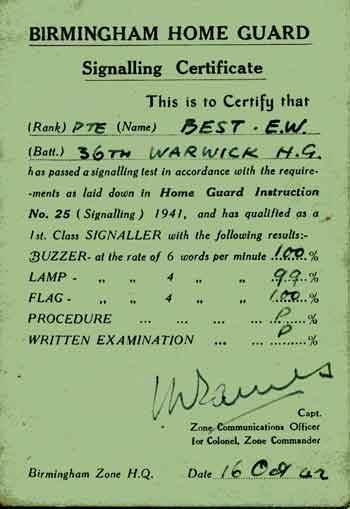
Pte. E.W. Best of the
36th Warwickshire (Birmingham) Battalion successfully passed his Signalling Test on 16th October 1942.
The 36th Warwickshire Battalion, commanded by
Lt. Col. A. Scrivener, M.C., (late Royal Warwickshire Regiment) was one of several Home Guard Battalions defending the Edgbaston area of the city.
(with grateful acknowledgement to Mick Ackrill, owner of the original certificate)
**********
HQ for the Birmingham Zone in which all Birmingham Home Guard Battalions served was in
Vicarage Road, Edgbaston.
Rex and Charles Owen, brothers both living with their families in Sheldon, were Despatch Riders attached to Zone HQ.
Rex and his wife, Flo, also had a remarkable
record of hospitality at their home to overseas
servicemen. The brothers' DR story is
here.
**********
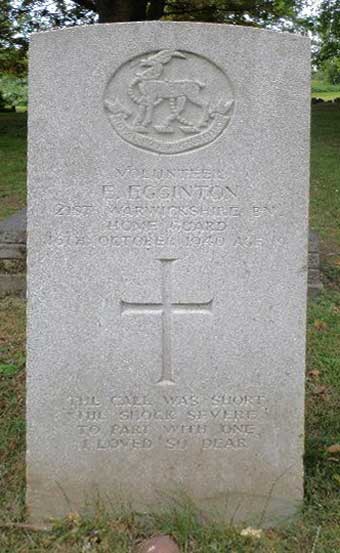
The
21st Warwickshire
(Birmingham) Battalion was based in
Edgbaston but had a wider geographical
responsibility, probably for factory Home Guard
units in various parts of the city.
The headstone
(left) in Lodge
Hill Cemetery of Vol. E. Egginton of the
21st Warwickshire
who died on 16th October 1940 at
the age of 19 years. He was the son of George
and Elizabeth Egginton of Selly Oak.
The circumstances
surrounding Ernest Egginton's death were described
the following day in a local newspaper, together
with several other tragedies. It is possible that
his place of work was
R.T. Shelley Ltd., motor accessory
maunufacturers, of Aston
Brook Street, Aston.
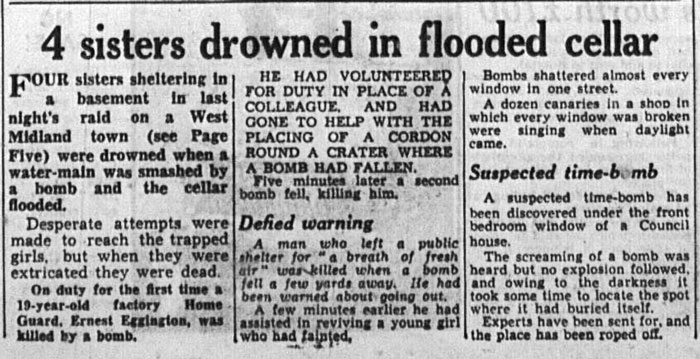
Grateful acknowledgement to
Maggie
Laity, Barbara Johnson, Colin Baker and Matt
Felkin and his "Wartime
Birmingham and the Blitz" Facebook page.
**********
The
34th Warwickshire (Birmingham) Battalion
was, like other units, based in Edgbaston but probably had
responsibilities over a wider area. This is
P/73 Platoon of "B" Company, photographed in August
1942, possibly at a weekend camp.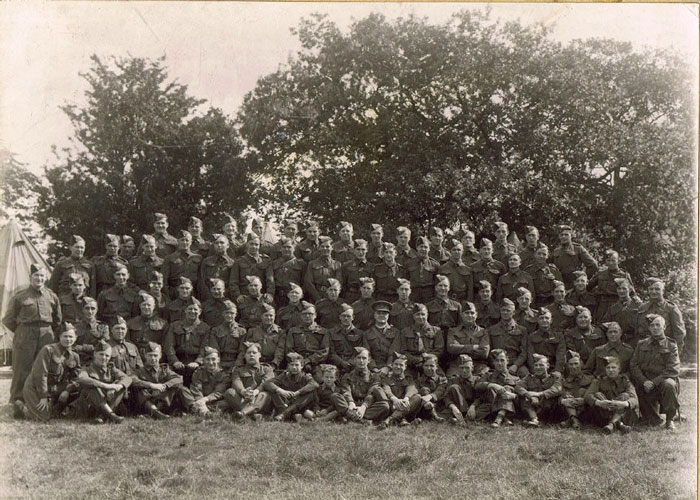
Grateful acknowledgement to David G. P. Morse
******************************************************************
BIRMINGHAM, ERDINGTON
Cpl. Arthur
Reginald Davis and
L/Cpl. Howard Fisher Morris
of "D" Company,
23rd Warwickshire (Birmingham) Battalion,
both teenagers, lost their lives as a result of
enemy action on July 30th 1942. There
was a heavy air raid on the city on that day. Arthur
Davis (an office boy in 1939) was killed at
3
Kingsbury Terrace, Victoria Road, Aston which was
his family home; and Howard Morris was killed at
9
Park Hill Place, Park Road, Aston. These
two young men, comrades in arms in the local Home
Guard, now lie together in Witton Cemetery.
This is their headstone:
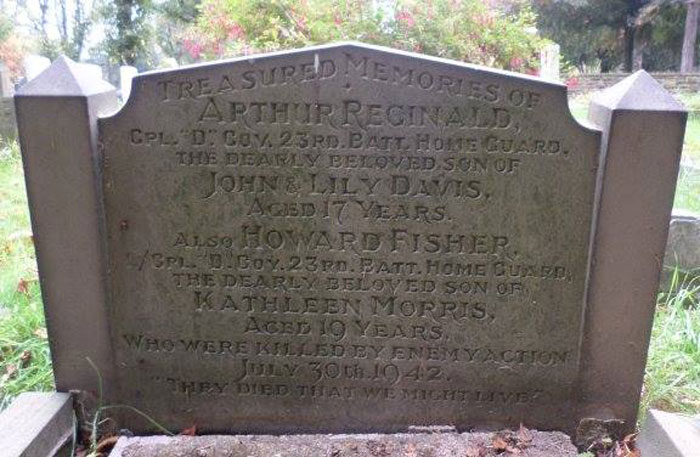
Grateful acknowledgement to
Maggie Laity;
and to Matt
Felkin and his "Wartime
Birmingham and the Blitz" Facebook page.
**********
Another member of the
23rd Warwickshire
(Birmingham) Battalion was
Lt. Leslie Beard
of Woodacre Road,
Erdington. Two pages of this website are
dedicated to his memory.
The main page gives details of his life and
contains several images of him and his comrades in
this Erdington Battalion.
The associated page show several images of
members of the Battalion receiving artillery
training at Umberslade
Park at Hockley Heath, involving the Blacker
Bombard Spigot Mortar and the 2-pounder gun.
**********
A further member of
the 23rd Warwickshire
was Joseph Bert Virgin.
He served between 2nd April 1942 and 31st December
1944. A surviving Certificate of Proficiency from
November 1943 confirms his membership of the
Battalion's "G" Company and its probable C.O. as
Major O. F. Rosbrook.
Maj. Rosbrook was originally listed as a lieutenant
in the February 1941 Officers List. Also confirmed
is the identity of the Battalion C.O. in late
November 1943: Lt.-Col. E.
W. Walker.
**********
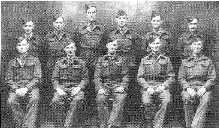
Click on this thumbnail to see a
further group of officers of the
23rd Warwickshire
(Birmingham) Battalion, with one officer,
Lt. Percy K. Kimberley,
identified.
**********
The
52nd Warwickshire
(Birmingham) Battalion
was also responsible for parts of Erdington. There is a
large group image of men from this Battalion,
possibly an entire Company, to be seen
elsewhere within this website. It is included
within a page concerning the
Castle Bromwich
Spitfire factory
as one of the men appearing was employed there.
It is not known, however, whether the Battalion had
any responsibilities in connection with that huge
facility.
******************************************************************
BIRMINGHAM, HALL
GREEN
This
page of the website gives information on
Alan Colin McLaren Lawson
and the battalion to which he belonged, the
42nd Warwickshire
(Birmingham) Battalion (or, just
possibly, the 24th
Warwickshire).
**********
Also, please see
BIRMINGHAM MOSELEY below
******************************************************************
BIRMINGHAM, HANDSWORTH (see
also HOCKLEY)
The 44th
Warwickshire (Birmingham) Battalion is known
to have had responsibilities in the Handsworth and
Hockley areas of the city. It is very likely to have
been a Battalion consisting mainly, or even wholly,
of factory units in that area.
**********
The story of
Lt. George Harry Griffiths who served with the
44th Warwickshire (Birmingham) Battalion in the unit responsible for the defence of the Great King Street factory of Joseph Lucas Ltd.
**********
And
the story of another member of the same Joseph Lucas group,
Lt. Zechariah Tolley M.M., can be read on an associated page. This includes information relating to his Great War service.
**********
Information concerning a third officer in this Battalion is also available.
Lt. Jock Orr was a career soldier and joined the 44th in 1941 after leaving the Regular Army.
**********
Sergeant
Eric Doody was another member of the 44th
Warwickshire. A glimpse of his life and service can
be seen on
this
page of the website, together with a superb
image of his Company, "B" Coy., photographed in July
1944.
**********
Within an interesting article entitled "Memories of Handsworth" in the
Handsworth History website, Paul Holmes relates his family Home Guard connection:
......At the time I was too young to remember have first hand knowledge but I was often told of the Endwood pub (on the far side of the park). According to folklore, my father defended this establishment from a German invasion when he was a member of the Home Guard. It would seem the defensive plan was simple: drink the place dry, leaving nothing for the invaders to plunder. I'm led to understand that the operation turned out to be one of the most successful of WW II, with the enemy not daring to venture within rifle-shot of the place.........
(Full and grateful acknowledgement is made to the above author and website. To read the full article, please click
here. Within the same website,
here, the author has also published fascinating information about the Hill Top anti-aircraft gun battery . You will leave this website in each case).
**********
The
46th Warwickshire (Birmingham) Battalion had a responsibility for areas of Handsworth and also I.C.I.'s huge Kynoch Works at Witton.
******************************************************************
BIRMINGHAM, HARBORNE
The
Stonehouse anti-aircraft rocket battery in
Harborne was manned by a Home Guard unit which
included Cpl. Eric
Holbeche.
************
A 1941 image of the
Harborne Home Guard Signals Company can be see
here. (You will leave this site).
************
Gunner Dennis Nash's
story
of serving on a Harborne anti-aircraft battery, which includes references to Quinton and Oldbury.
(You will leave this site).
******************************************************************
BIRMINGHAM, HOCKLEY
(see also ASTON and HANDSWORTH above)
Factory units in the
Hockley and Handsworth areas fell within the
responsibility of the
44th Warwickshire
(Birmingham) Battalion.
(See
HANDSWORTH
above).
************
Pte. Joseph Bennett
joined the
22nd Warwickshire (Birmingham) Battalion - which had responsibility for areas of Hockley and Aston - in Decenber 1940
at the age of fourteen-and-a-half and served until stand-down.
Click
here to read his story.
************
All the officers, warrant officers and N.C.O.s
of the
22nd Warwickshire (Birmingham) Battalion
were photographed in
October 1944 at the
Wesleyan Theological College in
Friars Road, Handsworth
(later
Hamstead Hall).
A high definition version
of this image is
available to view here.
************
Stanley Easthope,
of St John's Street,
Hockley, joined the 22nd Warwickshire (Birmingham) Battalion of the Home Guard
in 1942 at
the age of about 15. His father and uncle had both
seen service in the Great War. Stanley served until
late 1944 when he joined the Durham Light Infantry.
Thereafter he made a career of the Army and served
in postings throughout the world until his
retirement in 1981.
A
page describing his life and service now appears
in this website.
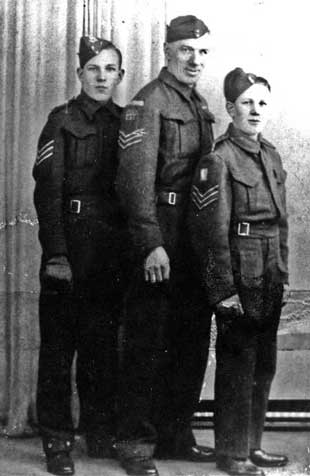 ************ ************
Sgt. Thomas George
Carlin
(1898-1949),
seen to the right with his two cadet sons,
Norman Thomas
(left)
and Eric William Henry
(right) served in the Coldstream Guards during the
Great War and was a member of the local
Home Guard in WW2. Although employed at
Wynn Tunnies(?)
& Co. he is thought to have been a member of
the Bulpitts & Co.
factory unit in Camden Street, Hockley.************
Also see
BIRMINGHAM, ASTON above for mention of two 22nd Battalion heroes of the Blitz.
*******************************************
BIRMINGHAM, KINGS HEATH
The story of L/Cpl. Alexander Schadowsky (later Alexander Sinclair),
a German national who joined the local Home Guard at a very early age and eventually served in the 71st Warwickshire Home Guard Heavy Anti-Aircraft Battery, “F” Troop.
******************************************************************
BIRMINGHAM, KINGS NORTON
Helen Kempster of The Friends
of Kings Norton is researching the Home Guard
in the area. She writes
(April 2014):
I've been trying to
find out more about the Home Guard in Kings
Norton Birmingham.
Our Parish Archive
(St Nicolas, Kings Norton) has several
references to their presence in our Tudor
buildings. In our Parish Magazines from the
1940s Cannon Dunn mentions the HG and "Mr
Robinson" as having their base in The Old
Grammar School. In 1942 they used the Church
tower for observation, and in 1943 they were
using the 'Saracen's Head' (built 1492!) for
'keep fit' training sessions and causing the
old timber building to vibrate.
The presence in Kings
Norton of
Major E
H Robinson - whom
all the records show as having commanded the
24th Warwickshire
(Birmingham) Battalion responsible for the Moseley area - is possibly
explained by his having commanded one of the
earliest formations, the
4th Birmingham
Battalion. Very
rapidly, in a matter of weeks following the creation
of the Home Guard, these early city units were split
down and new battalions were formed. It seems likely
that Major Robinson's involvement with Kings Norton
ceased with the creation of the
27th Warwickshire
(Birmingham) Battalion ,
probably in the course of the summer or early autumn
of 1940. That Battalion then had sole responsibility
for Kings Norton and Major Robinson thereafter
concentrated on his duties in Moseley
************
Two group
images of the 27th
Warwickshire (Birmingham) Battalion,
which covered Kings Norton, Bournville
and Northfield can be seen
on
this page. Also included is a memoir concerning
the Battalion's HQ Company C.O.,
Major A. F. Ward.
************
Images and
information on two factory units belonging to the
27th Battalion -
Cadbury's
at Bournville and
Kalamazoo at
Northfield - - can
be seen
on this page.
*******************************************************************
BIRMINGHAM, LADYWOOD
A press cutting from 1940 showing
Ladywood's canal patrol boat.
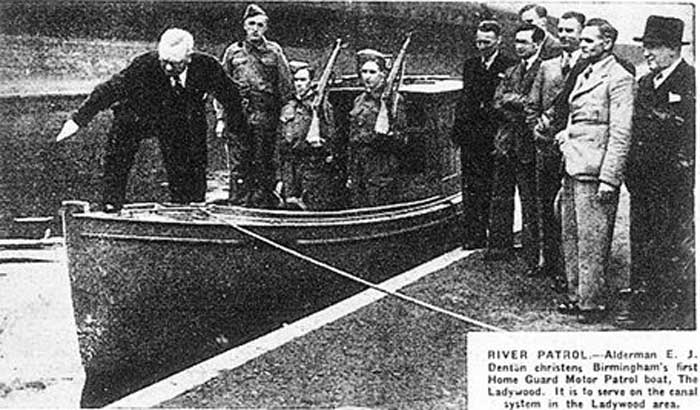
Grateful acknowledgement to
Matt
Felkin and his "Wartime
Birmingham and the Blitz" Facebook page.
******************************************************************
BIRMINGHAM, LONGBRIDGE
This page contains
images and information about the Austin Works
unit at Longbridge. Added
April 2015
******************************************************************
BIRMINGHAM, MOSELEY

The
24th Warwickshire (Birmingham ) Battalion was
responsible for areas of Moseley,
Sparkhill, Sparkbrook and
Hall Green.
Staffshomeguard is aware that there is information
on this Battalion available at the
Warwickshire County
Records Office (2020
opening hours: Wednesday to Friday and
Saturday morning).
Thanks to David Morse.
********
One of the
members of the 24th
Warwickshire was
Pte. George Samuel Belcher. George Belcher,
who lived in Sparkhill, was an apprentice toolmaker
at that time. His service included anti-aircraft and
searchlight duties. Information about him and the
Battalion, which includes high definition images of
many of its members as well as a group image taken
at a local anti-aircraft battery site, can be seen
on
this page of the website.
********
This
page of the website shows an image of No. 4 Platoon of "E" Company of the
24th Warwickshire (Birmingham) Battalion including one of its members,
Sgt. Jimmy Brown.
********
This page contains information and images
relating to one of the ten initial Birmingham
Battalions, the 4th
Birmingham Battalion (which later
evolved in the 24th
Warwickshire (Birmingham) Battalion and
others), commanded by
Lt.-Col. E.H.
Robinson, Headmaster of Moseley Grammar
School.
********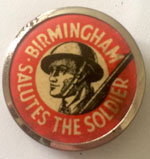
A member of the
24th Warwickshire Battalion unfortunately met a
premature death whilst serving within his unit.
He was Private Frank
George Wood, aged 58, a Works Manager of
77 Solihull Lane, Hall
Green. He suffered a fatal heart attack
whilst, despite his known condition, bravely
practising for a "Salute The Soldier" parade in his
area. This tragedy occurred on Wednesday 7th June
1944 - D-Day+1, a time of apprehension but great
hope.
Grateful acknowledgement to
Maggie Laity and
to Matt
Felkin and his "Wartime
Birmingham and the Blitz" Facebook page.
Headstone image © Maggie Laity 2017.
******************************************************************
BIRMINGHAM, NECHELLS
(See also ASTON above)
The
25th Warwickshire (Birmingham) Battalion, previously the 5th, was responsible for this area and its factories as well as parts of Aston. Click the heading above to read about this Battalion and about
M.B. Wild & Co. and its activities; the air raid on
L.H. Newton & Co.; and the involvement of
2/Lt. Harry Poppitt.
An image of the Battalion C.O.,
Lt.-Col. S.W.G.
Walker, and a number of its officers can be
seen here.
***********
Home Guard Volunteers
A.R. Beesley and
A.D. Morrall received Commendations for their work at Nechells Power Station during the blitz of November 1940.
************

Click on this thumbnail to see a group of officers of the Nechells unit.
******************************************************************
BIRMINGHAM,
NORTHFIELD
There is an excellent image of the Kalamazoo
factory unit
on this page.
(Please see also
BIRMINGHAM, KING'S NORTON above).
******************************************************************
BIRMINGHAM, PERRY BARR
The
50th Warwickshire
(Birmingham) Battalion was based in the
Perry Barr area. This image shows a small
detachment from this Battalion parading in a
location outside their area, on the
south-western edge of the city centre. They are
lined up on the corner of Easy Row and Paradise
Street.
The date and occasion of this event
are unrecorded. But one possibility, based on
the winter conditions and the location, is that
they are involved in the final stand-down parade
which marches through the centre of the city on
Sunday December 3rd 1944.
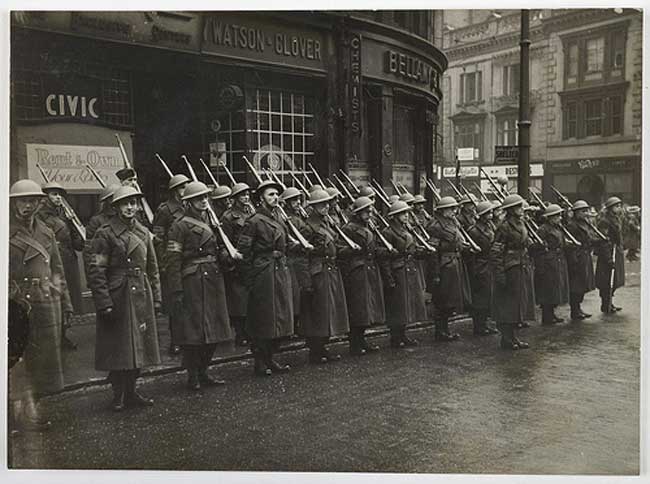
*********
Alf Bradbury
served in the Home Guard in Perry Barr and was
probably a member of the
50th Warwickshire
(Birmingham) Battalion. During
firewatching duties Alf produced a series of
wonderful sketches depicting Allied and German
armoured vehicles and intended for Battalion
training purposes. His story and the sketches
can be seen
on this page.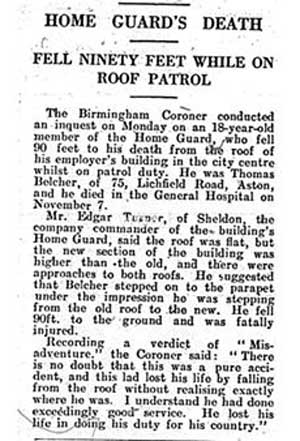
*********
Vol. Thomas Belcher,
a member of the 40th Warwickshire (Birmingham)
Battalion, died on 6th November 1940.
A newspaper records the inquest
(right).
Acknowledgement to
Matt
Felkin and his "Wartime
Birmingham and the Blitz" Facebook page.
*********
Another member of the
40th Warwickshire was
Arthur Taylor of 78
Treaford Lane, Alum Rock. Click on the link
to read his story and for several excellent images.
******************************************************************
BIRMINGHAM, QUINTON
There is information on
Quinton in the
Worcestershire section
of the website.
******************************************************************
BIRMINGHAM, ROBIN HOOD
Lt. E. J. Moon M.C. was an officer in the
42nd Warwickshire (Birmingham) Battalion of the Home Guard which was responsible for the defence of an area covering
Robin Hood, Sparkhill
and Acocks Green.
His page on this website includes a fully captioned image of the Battalion's officers and details of a celebratory dinner in 1944 at the Imperial Hotel, Birmingham.
******************************************************************
BIRMINGHAM, SELLY OAK
The 49th Warwickshire (Birmingham) Battalion covered the Selly Oak area (although the 27th had some responsibility for it, at least in the first years of the war). After stand-down a Comrades Association was formed which later evolved into the 49th Rifle and Pistol Club which still exists. There is a web page about the Battalion and its later history
here.
(You will leave this site).
******************************************************************
BIRMINGHAM,
SHELDON
Rex and Charles Owen, brothers both living with their families in Sheldon, were Despatch Riders attached to Zone HQ
in Edgbaston. Rex and his wife, Flo, also had a
remarkable record of hospitality at their home
to overseas servicemen. The brothers' DR story is
here.
******************************************************************
BIRMINGHAM, SMALL HEATH
This area of the city was defended by the
37th Warwickshire (Birmingham) Battalion, Home Guard, commanded by
Lt.Col. A.L. Paterson, M.C.
One of this Battalion's members was
Charles Herbert Skellett. Charles Skellett served in the Great War and in 1940 volunteered for the Home Guard, being appointed sergeant in March 1941. He regrettably did not live to see the peace as he passed away in February 1945, just two months after the Home Guard's stand-down.
His daughter has contacted this website and is
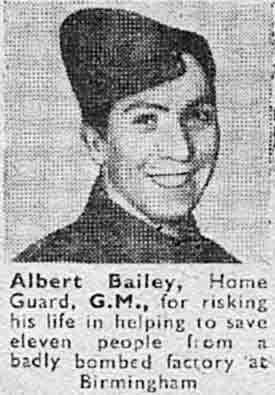 appealing for any information about this unit and her father's role in it, and especially for any unit photograph which may have survived. If you can help, please contact this website via
Feedback and we shall ensure that all information is passed on. appealing for any information about this unit and her father's role in it, and especially for any unit photograph which may have survived. If you can help, please contact this website via
Feedback and we shall ensure that all information is passed on.
**********
Several Home Guards, members of the 6th Birmingham Battalion, were honoured for their heroic work during the night of 19th/20th November 1940, when the BSA factory was bombed and many employees lost their lives. They were
Albert William Bailey who received the George Medal
(pictured right) and
J.H. Beattie, William Saragine and
Joseph Topham, the British Empire Medal.
These are extracts from a
contemporary newspaper report following the
announcement of various George Medal awards.
"Volunteer Bailey,
Home Guard, who receives the George Medal, was due
to report for duty at 9.30 p.m. on the night of a
heavy air raid on Birmingham. Hearing bombs, he
arrived at about 7 p.m. and remained on duty,
helping to deal with incendiary bombs. He went to
headquarters about 9 p.m. There he met an officer of
the Guard, who call for volunteers to rescue those
trapped under the debris of a building which had
suffered direct hits by bombs. Volunteer Bailey
first helped to rescue a Home Guard, and later, with
another Home Guard, got out two workmen from the
same place. He then went to the other side of the
debris, helped out a man and then a girl, and tried
to get through a hole but came to concrete.
He then attempted to knock a hole through the
concrete without success, a girder stopping
progress. An oxyacetylene cutter was used to cut
through this, and a girl and four men were got out.
A fierce fire was burning inside, but Volunteer
Bailey held up a piece of concrete with his arms for
some time and became saturated with oil and water.
He eventually collapsed near the entrance to the
hole and was taken home in an ambulance."
The same report mentions the award of George
Medals to Commander Rueben Haig, Washwood Heath; and
two Home Guards from units elsewhere in the
country.Volunteer David Lazarus, London; and
Volunteer Samuel John Ferguson. It also reports:
"One of the three Home Cards
awarded the medal of the Military Division of the
O.B.E. is Volunteer
Saragine, a dispatch rider. He was
continuously on the road visiting damaged places and
various firefighting stations during an enemy air
raid on Birmingham. On at least one occasion he
passed within a few feet of a delayed action bomb,
so that he might waste no time his journey."
(Acknowledgement: D.M.)
**********
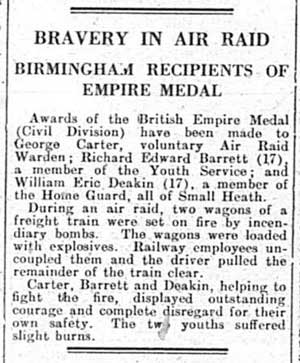
In a
separate incident another Small Heath Home
Guard, William
Eric Deakin, showed exceptional bravery and was
later honoured, together with Richard Edward
Barrett of the Youth Service and George Carter,
an ARP Warden.
Grateful acknowledgement to
Matt
Felkin and his "Wartime
Birmingham and the Blitz" Facebook page.
**********
Read
the story of a member of the
37th Warwickshire (Birmingham) Battalion.
Harold Lucas who worked on Lancaster tooling at William E. Farrer in Heath Mill Lane, Digbeth was later a member of the
107th Warwickshire Battalion which manned an anti-aircraft "Z" rocket battery on
Billesley Common.
**********
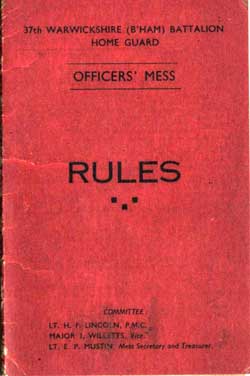
The booklet containing the
rules for the Battalion's Officers' Mess,
mentioning the name of
Lt. H. F. Lincoln,
P.M.C., Major J.
Willetts and Lt. E. F. Mustin, Mess Secretary and
Treasurer.
Grateful
acknowledgement to
Jacqui Fielding; and to Matt
Felkin and his "Wartime
Birmingham and the Blitz" Facebook page.
**********
The following image shows a group, almost
certainly a platoon, which was a unit in the
37th Warwickshire
(Birmingham) Battalion and/or a works
unit associated with a factory in the same area.
(In Birmingham, works
units were either part of the battalion responsible
for the geographical area in which a factory was
located; or part of a battalion which had a
specialised responsibility for similar units over a
wider area. Successors of the original
6th Birmingham Battalion
fell into the latter category: the
42nd Warwickshire
in the Small Heath area was one of them).
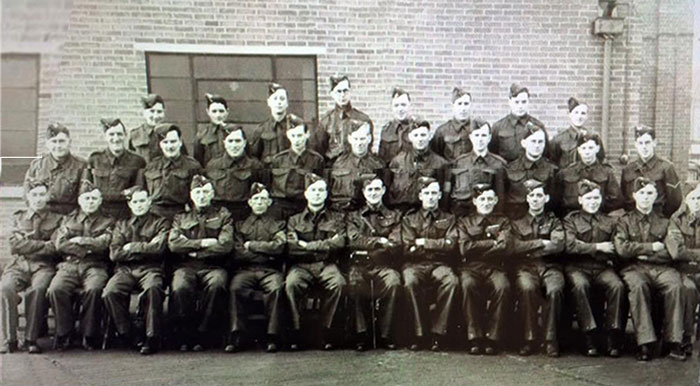
George Owen Millward
is located fifth from the right, middle row, in the
above image. He
lived in Golden Hillock
Road. He was a millwright and worked at
B.S.A., Small Heath; this was a reserved occupation
which prevented him from joining the regular forces.
George was unwell and off work when the
factory suffered its devastating attack during the
night of 19/20th November 1940 and he was fortunate
in surviving whilst many of his fellow employees
lost their lives. Several members of George's family
also worked at the factory at the same time and they
were all fortunate in surviving. George's King George VIth Commendation certificate confirms that he served
in the Home Guard between December 1940 and October
1943; after a break in service he rejoined in August
1944 and served until stand-down in the following
December.
Jack Menzler, of
Imperial Road, Small
Heath, is located in the second row, second
from the left. Jack's family have provided a memory
of him and his service:
"Jack was
with the Home Guard from the beginning of the
war until it was disbanded in December 1944. His
operational area was
Small Heath and
Bordesley Green
and his primary responsibiity was "Fire watch".
This was particularly important as many bombings
were executed using incendiary ordinance which
started many fires in commercial and residential
areas. These outbreaks needed to be identified
and extinguished as quickly as possible. Jack's
day job was as a Vehicle Inspector at the
Morris-Commercial
works in Birmingham and by night he and
his fellow comrades in the Home Guard were the
watchful eyes and protectors of their
communities".
The photograph was taken at the Royal Warwickshire
Regiment Barracks on
Golden Hillock Road (which has survived into
the 21st century and is now home to the Royal
Signals Territorials). The building on the very
edge of the picture appears to be the one on the
corner of Ansell Road.
Grateful acknowledgement to
Jackie
Cotterill, daughter of George Millward; to Matt
Felkin and his "Wartime
Birmingham and the Blitz" Facebook page; and
to John and Rod Menzler of Brisbane for information about
their father/grandfather.
**********
Capt. H. W. "Bert" Webb commanded the HQ
Company of the 37th
Warwickshire (Birmingham)
Battalion.
Two pages within this website are dedicated
to him and contain several high-quality group images
of him and his comrades with a number of the men
identified.
**********
Another
member of the 37th
Warwickshire was
Frank Carter. His story includes a description
of the remarkable events in which he was involved
immediately before his volunteering for Home Guard
service.
**********
See also
SPARKBROOK below
******************************************************************
BIRMINGHAM, SPARKBROOK/SMALL HEATH
The life of Lt. Leslie McGregor of the
37th Warwickshire (Birmingham) Battalion
is remembered in this website.
******************************************************************
BIRMINGHAM, SPARKHILL
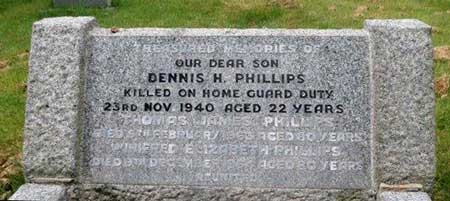 Vol.
Dennis Herbert Phillips
(b.1918) of the
47th Warwickshire (Post Office) Battalion
lived in Sparkhill. He lost his life when on
duty on 23rd
November 1940 at the age of 22. He
was one of the victims of a direct hit on the
47th Battalion guard room during the severe
overnight raids
of 22nd/23rd November on various parts of
Birmingham. Another Home Guard was killed in
the same incident. Dennis Phillips now rests with his
parents in Solihull Cemetery. Vol.
Dennis Herbert Phillips
(b.1918) of the
47th Warwickshire (Post Office) Battalion
lived in Sparkhill. He lost his life when on
duty on 23rd
November 1940 at the age of 22. He
was one of the victims of a direct hit on the
47th Battalion guard room during the severe
overnight raids
of 22nd/23rd November on various parts of
Birmingham. Another Home Guard was killed in
the same incident. Dennis Phillips now rests with his
parents in Solihull Cemetery.
A
separate page of this website contains the
formal reports written by various Home Guards who
were involved in this tragedy.
(Grateful acknowledgement to Maggie Laity and
Colin Baker; and to Michael Minton's "Heroes
of the Birmingham Air Raids").
**********
Sgt. Horace Frederick Rockett, together with
his wife Kate and their 16-year-old daughter Beryl,
died during the night of 11/12th December 1940 when
their home at 85
Leominster Road, Sparkhill received a direct
hit. Horace had served in the Coldstream Guards
during the Great War and had been wounded twice. He
volunteered for the Home Guard at its formation and
served as a Sergeant in the
4th Birmingham Battalion,
one of the ten initial battalions in the Birmingham
area.
(Grateful acknowledgement to
Andrew Thornton; and to Matt
Felkin and his "Wartime
Birmingham and the Blitz" Facebook page).
**********
One of the
members of the 24th
Warwickshire (Birmingham) Battalion, based in
Moseley, was
Pte. George Samuel Belcher. George Belcher,
who lived in Hillfield
Road, Sparkhill, was an apprentice toolmaker
at that time. His service included anti-aircraft and
searchlight duties. Information about him and the
Battalion, which includes high definition images of
many of its members as well as a group image taken
at a local anti-aircraft battery site, can be seen
on
this page of the website.
**********
For further
references to Sparkhill, please see
BIRMINGHAM, ROBIN HOOD
and
BIRMINGHAM, MOSELEY
******************************************************************
BIRMINGHAM, STECHFORD
(see also BORDESLEY GREEN)
Here are
images and information concerning the Stechford Home Guard, the
39th Warwickshire (Birmingham) Battalion which included a Rover factory unit,
and one of its
long-serving members,
Eric Pain. Also
memtioned is the Grand Concert
(see below).
************
This page contains images of the Official
Programme for the fund-raising Grand Concert
organised by the Battalion at the Alexandra Theatre in Birmingham in December 1941;
and also of all the units within the Battalion
including many of their members.
************
The Copsey brothers of Charles Edward Road, South Yardley had close dealings with local units, the elder, Dennis, with the
38th of which he was a member before being called up as a Bevin Boy; and Len with the
39th which provided help with his military training as a young cadet. Their story is
here.
************
Here is information on
Sgt. Jim Baker of Fordrough Lane and the Bordesley Green Home Guard unit of which he was a member, "B" Coy. of the
39th Warwickshire (Birmingham) Battalion.
************
And reminiscences and images from another member of the
39th Warwickshire (Birmingham) Battalion,
Pte. Geoffrey Bennett including the night when he and his section overran Elmdon Airport!
************
Pte. William Henry Bryan
was probably a member of the
39th Battalion
also. His activities at
Marston Green are
described
here.
******************************************************************
BIRMINGHAM, STOCKLAND GREEN
Read about the night when
John Welch of
Hidson Road received a knock on the door from the local Home Guard.
******************************************************************
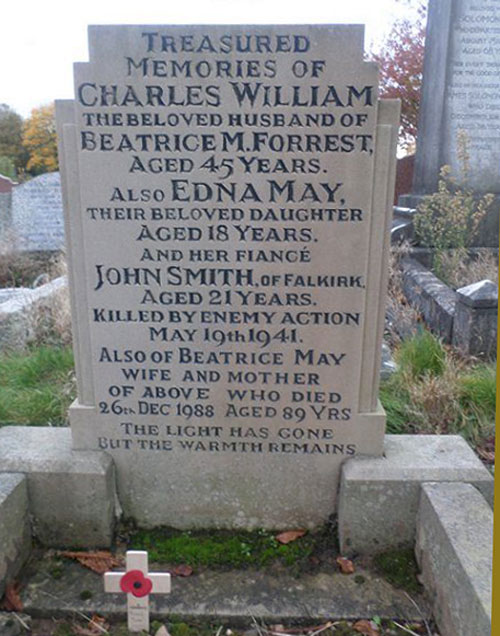 BIRMINGHAM,
WARD END BIRMINGHAM,
WARD END
Volunteer Charles William Forrest, aged 45,
of the 37th Warwickshire
(Birmingham) Battalion together with
members of his family, lost his life following an
air raid on the Wolseley factory at Ward End on the
16th May 1941. This is his headstone which includes
the names of his daughter and her fiancee who died
as a result of the same incident. Also included is
his wife, Beatrice, who was destined to live for a
further 47 years.
His name is recorded in the
Birmingham Register of Civilian War Casualties:

(Grateful acknowledgement to Maggie Laity and
to Matt Felkin
and his "Wartime
Birmingham and the Blitz" Facebook page).
******************************************************************
BIRMINGHAM, WASHWOOD HEATH
Home Guard Volunteer
Reuben Haigh, a gas clerk at the
Washwood Heath gasholder, was awarded the George Medal for his bravery there during the blitz of November 1940. Vol.
S.A. Tyler received an official Commendation for his work during the same incident.
The Times on
12th February 1941 reported the Citation which had
appeared in the London Gazette:
"At
about eight p.m. on 22nd November 1940 a number of
incendiary bombs fell on the
Wagon Repair Shops
and on Washwood Heath Gas
Works. Haigh
was P 19 Company Duty Officer and after one or two
small fires in P 19 area had received attention, he
proceeded, with Volunteer
A. S. Tyler, to the Gas Works. They found two
fires in the coal stack and extinguished them. Two
smokescreen containers had been ignited and were
burning with considerable flame. These, in the
absence of equipment for dealing with oil fires,
were extinguished with some difficulty. There was a
plume of flame in the crown of one gas holder; at
the time the crown on the gas holder was some 200
feet high. Haigh, taking the initiative and with
three other men, ascended to the crown of the holder
carrying sacks, and after considerable effort
extinguished the fire and partially stopped the
escape of gas with bags and clay. Another aperture
in the crown of the holder, through which gas was
escaping but not burning, was dealt with in the same
way. No protective equipment was carried. The raid
was still in progress, with bombs dropping in the
vicinity, and the flame from the holder must have
provided a continuous beacon. The action taken by
Haigh and the other three men not only promptly
removed the beacon but also saved a considerable
quantity of gas from escaping."
Please see also the
History of the
29th
Warwickshire (Birmingham) Battalion.
(Acknowledgement:
D.M.)
************
-
Information and images relating to the
35th Warwickshire
(Birmingham) Battalion which consisted
of members of the Birmingham Auxiliary Fire Service (A.F.S.)
; and of A.F.S. Depot 6/1 which was located in
Washwood Heath.
******************************************************************
BIRMINGHAM, WITTON and GREAT BARR
Mr. Stan Arthurs wrote of his Home Guard experiences for the BBC People's Archive:
".........My story begins in 1939 when I answered a call to join the "Local Defence Volunteers" (LDV). Issued with an armband and a truncheon, I patrolled the outskirts of the GEC at Witton, confident with the information that any German paratrooper, unstable as he landed would be easy meat. This I did for two hours per night, three times a week. Quite rough on a 17 year old working a 48 hour week!
Then the "Home Guard". Armed with a Canadian Ross rifle and five rounds, I was stationed on the flat roof of the Clifton cinema at Great Barr. With the bombs
whistling overhead and shrapnel falling like rain, our job, again three nights a week, was to sight major city explosions and fires and declare the sighting angle. Together with similar sightings carried out at other high points the convergence gave a near indication of the bombed area.
So, I was pleased in 1941 to be released by my employers to join the RAF.......... "
©
Stan Arthurs 2005 To read the rest of this article, entitled
The Horsa Glider,
please click here. (You will leave this site. WW2 People's War is an online archive of wartime memories contributed by members of the public and gathered by the BBC. The complete archive can be found at
www.bbc.co.uk/ww2peopleswar.)
**********
Mr. Kenneth
Laight writes about his father's service at
Witton:
My father,
Stanley Laight, was in the 46th
Battalion. He worked at
Higgs Motors
as a universal grinder and cutter.
I was born in 1939 and so my recollection
of dates is rather unclear. I do recall an
event which started at something like a range
on the edge of Witton Cemetery - there was some
shooting and some bangs and other
demonstrations of military activity.
Afterwards we all walked to the HQ at Witton
where there was some form of entertainment
including tea and sandwiches. I am unsure of
the date but I assume it was 1944 or 45. I
assume this activity was only of platoon size
as there were only about 20 soldiers taking
part.
I recall my father in uniform and that he
did night firewatching which he said was at
Higgs Motors, Witton. I also have a
recollection that he sometimes brought his
rifle home. I presume my father is somewhere
on
the large photo but could not identify
him.
(Grateful thanks to Mr. Laight for this
memory. Mr. Laight himself
served in
the Royal Warwickshire Regiment as a National
Serviceman in 1960 and retired in 1994 with
the rank of Lt.-Col.)
******************************************************************
BIRMINGHAM, WITTON - GEC WORKS
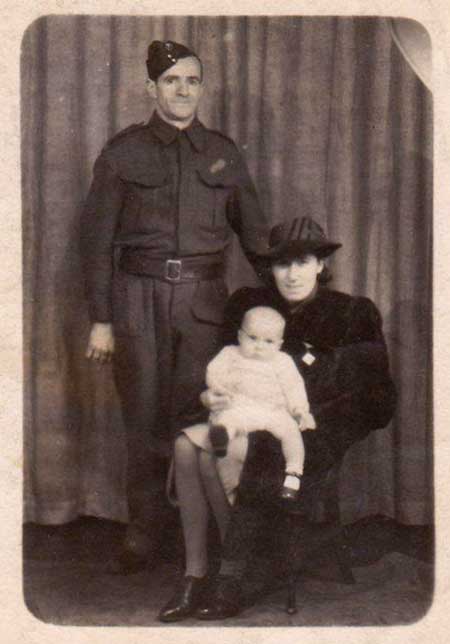
This Company, like all major factories in the area, had its own works Home Guard unit. It was part of the
46th Warwickshire (Birmingham) Battalion. Just one of its members has been so far been identified with reasonable certainty.
Samuel Rhodes (1903-1953) lived in Westwood Road. He had been born in Birmingham but spent his early life from the age of nine in Canada, returning in the mid-1930s. The war years found him working at the G.E.C.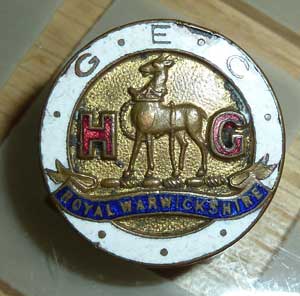
Just two relics from those times survive: his G.E.C. Home Guard lapel badge and an image of him in uniform taken in autumn 1944 with his wife and newly born son.
(Grateful acknowledgement to Julie Thacker, Samuel's granddaughter, for providing this information)
******************************************************************
BIRMINGHAM, WITTON - KYNOCH WORKS
The Kynoch Works at Witton was during the war the Metals Division of Imperial Chemical Industries Ltd. and a major contributor to the national war effort. This website contains information on its long history, from 1862 to the present day, some of its wartime experiences and its large Home Guard unit, 'B' Company of the
46th Warwickshire (Birmingham) Battalion. See:
Kynoch Works Home Guard - main page
Kynoch Works Home Guard - a 1942 report
Kynoch Works Home Guard and Lt. E. Long
and also
46th Warwickshire (Birmingham) Battalion
Kynoch Works - air raids
History of Kynoch Works 1862-2008
******************************************************************
BIRMINGHAM, YARDLEY
One unfortunate officer
of the Yardley Home Guard, and his wife, became a
victim of the Blitz a long way from home.
He was
Mr. F.W.T. Charles of
191, Queen's Road, Yardley, a
testing officer with the G.P.O. and a member of the
Birmingham G.P.O. Home Guard, the
47th Warwickshire
(Post Office) Battalion. He and his wife were
killed in Willesden, London.
(Click on title to view).
|
| OTHER WARWICKSHIRE TOWNS AND VILLAGES |
BIDFORD-ON-AVON
Bidford was defended by a Platoon of the
4th Warwickshire (Stratford) Battalion. One of its members was
Pte. Kenneth David Boyles. Read his story
here.
**********
COVENTRY
Arthur John Northwood
was a member of one of the several Coventry
battalions or of the
1st Warwickshire (Warwick) Battalion. He participated at a remarkable event at Kenilworth Castle where
at least a dozen Home Guard Beaverettes and many Despatch Riders paraded for
the benefit (one assumes) of a number of high-ranking Home Guard
officers. The date of this demonstration is unknown but some excellent
images survive and are reproduced here, on
this page of the website.
**********
An interesting image of members of the
Coventry "B" South Sector Home Guard Signals
Section photographed on 12th November 1944:

(With grateful acknowledgement to
David Morse)
Added 3rd February 2024
**********
A happy group of
12th Warwickshire (Coventry) Battalion men having a breather
during a training exercise.
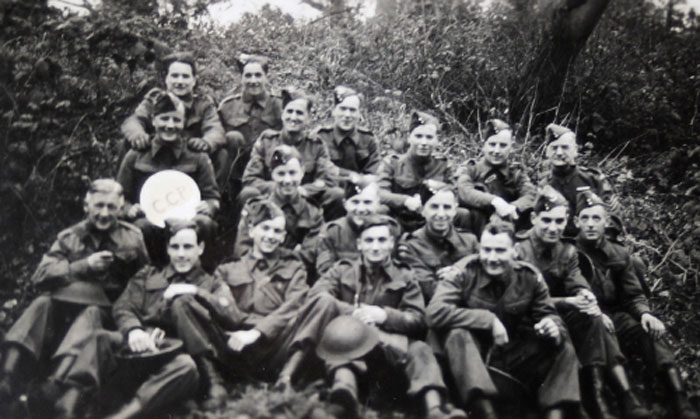
Acnowledgement to
an anonymous Warwickshire HG
historian
 ********** **********
15th Warwickshire (Coventry) Battalion
To see images of and interesting information about the
Humber Works Home Guard - part of the 15th Warwickshire (Coventry) Battalion - and about an adjacent battalion, the 16th Warwickshire (Coventry), click here.
That linked site also contains details of the several Coventry Home Guard
men who lost their lives.
(You will leave this site).
Philip Aidan Brain
(right)
worked in a reserved occupation and was a member of the Humber factory HG unit. He
served as a Despatch Rider and was also heavily involved in recovery activities after
the blitz on the city. He recalled the moonlight on the night of the
November 1940 raid
as being "as bright as day".
(Grateful
acknowledgement to his daughter, Mrs. Anna Phillips of Marton and to David G. P. Morse. )
**********
16th Warwickshire (Coventry) Battalion
On Saturday August 28th 1943 the 16th Warwickshire (Coventry) Battalion held a Gymkhana and Battalion Sports event at the Rugby Football Ground, Coundon Road, Coventry, from early afternoon until dusk. It was an elaborate affair with many displays and competitions involving HG and non-HG participants. The detailed programme of this event, which names many local people ranging from Master Jimmy Clews (aged 3 years and 10 months giving an exhibition of horse-riding) to the Battalion C.O., Lt.-Col. W.H.J. Gould, can be seen here. (See also 15th Battalion, above)
In the winter of 1942, the 16th Warwickshire (Coventry) Battalion received a Defence and Training Instruction, typical of the flood of paperwork pouring down on Home Guard battalions at that time. You can read it here.
**********
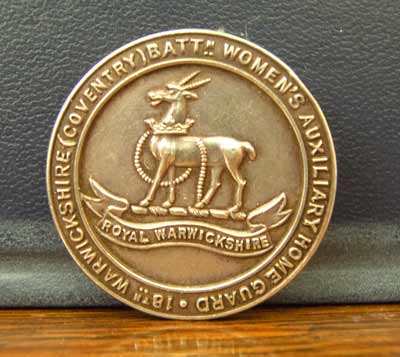 18th Warwickshire (Coventry) Battalion 18th Warwickshire (Coventry) Battalion
The Women's section of the 18th Warwickshire (Coventry) Battalion had their own insignia in the form of a handsome medallion inscribed "18th Warwickshire (Coventry) Battn. Women's Auxiliary Home Guard".
This is shown to the right.
Grateful acknowledgement is made to Mr. Paul Cragg for providing this image.
Both he and staffshomeguard would welcome any information about this insignia and the unit it denotes. Not much seems to be known about the 18th Warwickshire and still less about its women's section. Please respond via
FEEDBACK)
Further information about
this type of medal has subsequently come to light (Dec. 2017). It is
thought that it was a commemorative medal issued to Women Auxiliaries in
Coventry at the time of stand-down in Decmber 1944. A variant, coloured
silver but otherwise identical, is known also to exist.
(Ack: David G. P. Morse)
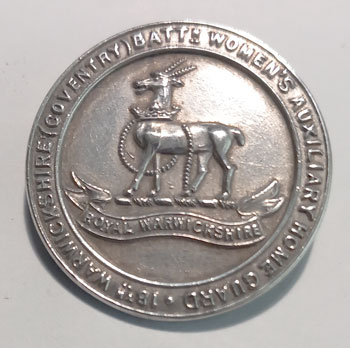 |
And, in 2024, the silver variant has come
to light.
(Again, with grateful acknowledgent to
David Morse) |
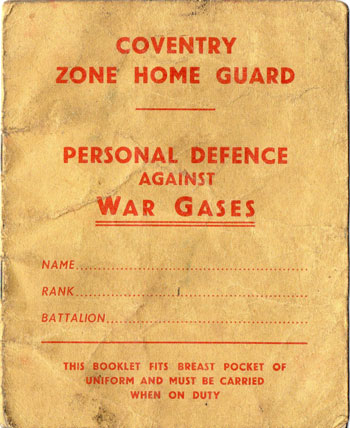
Little is so far known about the
activities of the 18th Warwickshire Battalion. Just fragments of information
have surfaced:
Colonel C. W. Clark
D.S.O., M.C. (late of the Tank Corps) was its first
Commanding Officer, superseded in due course by
Lt.-Col. E. C. Dickinson.
Reports survive of various social
and fundraising activities by the Battalion. On one occasion a dance was
held at the Drill Hall with the proceeds being in aid of the Red Cross and
St. John Prisoners-of-War Fund. The Royal
Warwickshire Regiment Dance Band provided the music. The M.C. was
Captain C. H. Jinman. On another occasion "A" Coy. put on a revue entitled
"This is the Home Guard" which resulted in a sum of £65 pounds being raised
and contributed to the "Coventry Evening Telegraph" Parcels Fund. A cheque
was handed over by Captain J. H. King of
"A" Coy.
(Grateful acknowledgement to David G. P. Morse)
**********
The interesting reminiscences of Mr. George Pearson in his local unit whose HQ was the Bull & Anchor in Wheelwright Lane. (You will leave this site). **********
Here is the exciting story of how
Pte. Frank W.C. Smith and his Home Guard comrades defended his factory, A.C. Wickman Ltd., from the Drawing Office roof during a daytime attack by a lone Junkers 88 on Friday, January 10th 1941. (You will leave this site).
**********
Interesting details of life on a Coventry AA Rocket battery in Memorial Park are provided by Mr. H.J. Poulter. (You will leave this site).
**********
The Home Guard unit of George Wilson Gas Meters investigates a suspected spy in the factory in Put One Up The Spout Fred. (You will leave this site).
**********
After experiencing the blitz in Wallasey, Mrs. Margaret Andrews (nee Parrott) recalls happier times in Coventry:
"........Because our house was destroyed by a bomb we moved to Coventry. I was now 20, and although I had signed up with my age group to join the forces I was sent to Morris Motors. Once again my life changed and I was working in a factory making munitions and new friends who were also strangers to factory life.The memory of Coventry was joining the 18th Battalion Warwickshire Women’s Home Guard, one of the few forces in England. Apart from the bombs life was good with many new friends. We formed a concert party comprised of talented people from the munitions factory who came from all over the country. Our audiences were the RAF and Army boys stationed around Warwickshire.I have very fond memories of the last show of the Home Guard, “This is the Home Guard”, which was held in the Coventry Hippodrome on the 3rd of December 1944. Our audience of over 500 packed the theatre and came from camps all over Warwickshire. That I think is the memory I have of war days. The joy and the pleasure of hearing them sing our songs and their songs; the applause we had was wonderful. At the end of this last show a senior officer thanked us and presented us with a silver medal for all our work. It reads: 18TH WARWICKSHIRE (COVENTRY) BATTN WOMEN’S AUXILIARY HOME GUARD.The war ended in September 1945. We celebrated in London and had the honour of walking in the victory parade.
My experiences in the Home Guard were very different from the war days I knew and went through in my home town. War changes lives but memories live forever. I made many good friends and my family was very fortunate as we all survived.........."
© Margaret Andrews 2004 To read the whole of this interesting memoir in its original setting, the BBC's excellent People's War Archive,
please click here. (You will leave this site. WW2 People's War is an online archive of wartime memories contributed by members of the public and gathered by the BBC. The complete archive can be found at www.bbc.co.uk/ww2peopleswar.)
**********
Within a fascinating and moving memoir of a city under attack, A Child's War: In Coventry, Mr. Peter Cox describes a city centre exercise where the local Home Guard takes on a unit of battle-hardened Polish troops. (You will leave this site).
******************************************************************
HILMORTON
In My War in the Local Defence Volunteers, Mr. Ken Clark gives an interesting description of his service in the Hilmorton unit and later with the Singer Motors factory unit in Coventry.
(You will leave this site).
**********************************************************
KENILWORTH
Arthur John Northwood
was a member of one of the several Coventry
battalions or of the
1st Warwickshire (Warwick) Battalion. He participated at a remarkable event at
Kenilworth Castle where
at least a dozen Home Guard Beaverettes and many Despatch Riders paraded for
the benefit (one assumes) of a number of high-ranking Home Guard
officers. The date of this demonstration is unknown but some excellent
images survive and are reproduced here, on
this page of the website.
**********
2/Lt. F.C. Collings of
Malthouse Lane, Kenilworth
is summoned to an important 41
Mobile Company Parade next Sunday morning, 30th July 1944. This
Company was part of the 1st Warwickshire (Warwick) Battalion.
(with thanks to D.M.)
**********************************************************
KINETON
An
image of the Kineton unit, part of the
4th Warwickshire (Stratford)
Battalion, can be seen on
this page of the website.
**********************************************************
KNOWLE and DORRIDGE
A glimpse of an earlier WARWICKSHIRE Home Guard. Click the title to see an image of the Knowle and Dorridge Volunteers in September 1918.
******************************************************************
LEAMINGTON SPA (See also Warwick)
Leamington, Warwick and
adjoining areas were defended by the 1st
Warwickshire (Warwick) Battalion. There are several pages of
images of this Battalion
elsewhere within this website.
*********
Sidney Flavel & Co. Ltd. was, and under a different name continues to be, a large factory producing gas appliances. It was big and important enough to justify its own Home Guard platoon as well as other factory defence personnel. The Home Guard unit was part of the 1st Warwickshire (Warwick) Battalion commanded by Lt.-Col. J.H. Alexander, DSO, MC. In that period there was published a regular factory defence newsletter/magazine entitled "Eagle News". Three surviving copies of this, from 1942 and 1944 and mentioning various personnel, have been reproduced.
Click here to view.
*********
"We You Salute - Your Local Dad's Army" by the late Mr. Roy Rowberry (one time private in No. 8 Platoon, "B" Coy., 1st Warwickshire Battn.) is a book published in 1990. It contains much information about the various Home Guard units in Leamington, including the Flavel and Lockheed factory platoons; and contains many illustrations supplied by various private contributors. One assumes that it is long since out of print but second-hand copies can still be obtained. It is well worth the effort of seeking one out.
******************************************************************
MARSTON GREEN
Pte. William Henry
Bryan served in the Marston Green unit of which an excellent image
taken at Chapel House Farm may be seen
here. It has yet to be
confirmed whether this unit was part of the 39th
Warwickshire (Birmingham) Battalion or the
5th Warwickshire (Solihull) Battalion. Further information
about both Battalions is available elsewhere in this website.
OLTON
Vol. Cyril Jones,
a member of the local Home Guard. died in
Solihull Hospital on 20th December 1940 as a
result of injuries sustained during the evening
of 22nd November. On the night of
22nd/23rd November heavy attacks were made on
various areas of Birmingham including Elmdon.
Cyril was not on duty at the time but was in the
hallway of his home which he shared with his
widowed mother at 91
Ulverley Green Road.
His injuries were caused by shrapnel from a bomb
which exploded just outside the house. He was 19
years of age.
(Grateful acknowledgement to Matt Felkin and the
Solihull.gov.uk
website)
******************************************************************
RUGBY (including FENNY
COMPTON and WORMLEIGHTON)
In 1989 this article was printed in the Midweek Advertiser,
remembering men involved in events which had occurred 47 years previously.
They are members of "J" Coy., 2nd
Warwickshire (Rugby) Battalion.
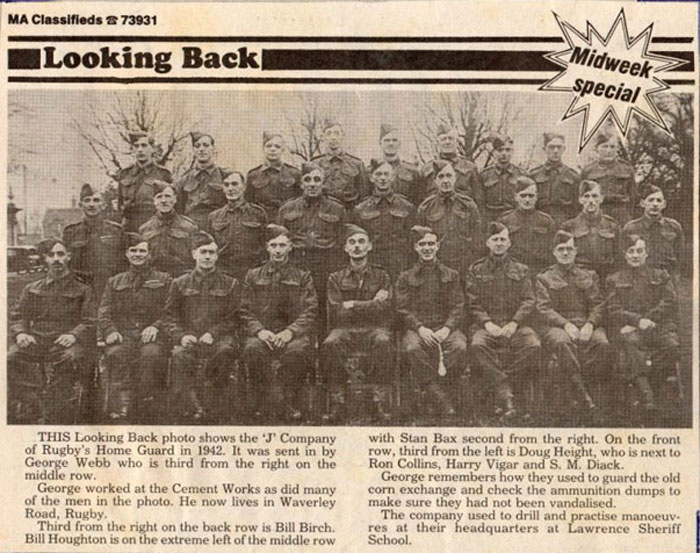
(Grateful acknowledgement to David Morse, the
Midweek Advertiser and the families of the men named).
*********
The
Fenny Compton/Wormleighton
platoon, part of the 2nd
Warwickshire (Rugby) Battalion, was the subject of a brief history
written by it final C.O.,
Lt. Ronald H. Brime
(or Prime/Grime/Drime).
Read this interesting document
on this page.
(Grateful acknowledgement to
David Morse)
******************************************************************
SOLIHULL
Lt.
Gerald George Cates of
5 Winterbourne Road, Solihull
and a member of the
5th Warwickshire (Solihull) Battalion
lost his life in April 1942 in a "friendly-fire" accident at a Combined
Services demonstration at Imber Down on Salisbury Plain. His comrade,
Capt. D. Hirons also attended but escaped
injury.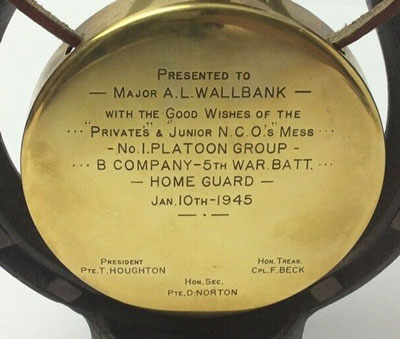
*********
This gong was presented to
Major A. L. Wallbank (presumably
Company Commander) on 10th January 1945 with the good wishes of the
"Privates and Junior NCOs Mess", No. 1 Platoon
Group, "B" Company, 5th Warwickshire Battalion, Home Guard. The
President of the Mess was Pte. T. Horton,
the Hon. Treasurer Cpl. F. Beck and the
Hon. Secretary Pte. D. Norton.
(Acknowledgement: D.M. and eBay sale notice August
2019)
*************************************
SOUTHAM
"C" Coy., of the 2nd
Warwickshire (Rugby) Battalion was responsible for the defence of
Southam and the
adjacent area. The linked page contains images and the names of some of this
unit's members.
******************************************************************
STRATFORD-UPON-AVON
Four members of the 4th Warwickshire (Stratford) Battalion
look on whilst the youngest does all the digging!
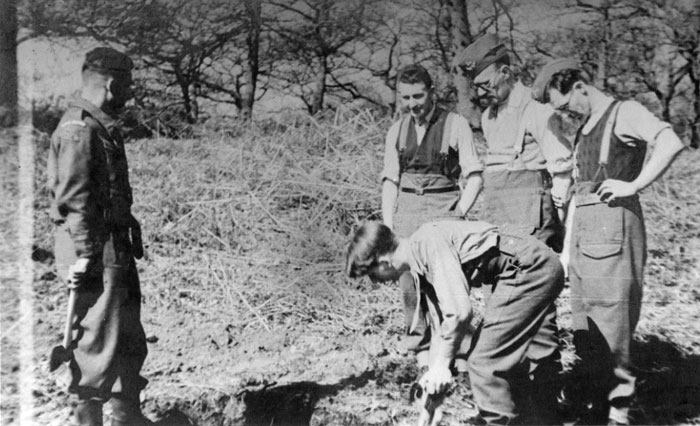
Acnowledgement to
an anonymous Warwickshire HG
historian
**********
The Bidford Home Guard was part of the
4th Warwickshire (Stratford)
Battalion. One of its members was
Pte. Kenneth David Boyles. Read his story
here.
**********
Mr. Greg Bartlett is seeking information relating
to a memory he has of playing as a child in woodland behind
Anne Hathaway's Cottage. This memory is of a rifle range, possibly belonging
to the Home Guard, of which little remained by that time apart from some
structure for the raising and lowering of targets and some buildings which
had disappeared by the 1990s. If any visitor to this website has any
information, please contact staffshomeguard using the Feedback link at the
foot of this page.
******************************************************************
SUTTON COLDFIELD
Click here to read about several members of the Sutton unit, the 6th Warwickshire (Sutton) Battalion, including mention of
Lt. Jack Kemp
of Boldmere,
Lt. Rupert Thomas of Four Oaks and a memoir of Lt. Harold Pearce of Boldmere.
**********
Captain John Reardon Brosch was another member of the 6th Warwickshire. Click to read his story and see group images of units within the Battalion.
**********
Sgt. William Thornton and Cpl. Douglas Thomas also served in Sutton in the 6th Warwickshire. Read their illustrated story as remembered by William Thornton's son; within it are other memories of the town in wartime and also mention of Cpl. Peter Bate (see below).
**********
This 1941 diary written by Cpl. Peter Geoffrey Bate of Mayfield Road provides fascinating glimpses of the Sutton Coldfield Home Guard and of other aspects of life in the town at war.
**********
Wilfred George
Vernon Knott, who lived in Penn's Lane
and was in a reserved occupation as a
tool maker, is likely to have been a member of the 6th
Warwickshire before being transferred to anti-aircraft duties for which
he served as a sergeant in the 105
Warwickshire Home Guard Rocket A.A. Battery.
An excellent, detailed image of Sgt. Knott and his anti-aircraft battery
comrades is available on
another page of this website.
**********
Cpl. Rudge,
an unknown member of the 6th Warwickshire (Sutton) Battalion,
owned a map of Sutton
Park on which, in 1943, he noted points of interest associated with
his Home Guard activities in the park.
*********
Staffshomeguard has received
this appeal:
Sutton Coldfield Rifle
And Pistol Club celebrates seventy-five years of existence this
year (2019). The club was formed by members of the Home Guard in Sutton
Coldfield. Copies of any documents or photos relating to the original
formation of the club would be gratefully received for our archives.
Many thanks".
If you can help, please respond via
FEEDBACK
to this website.
**********
A very early image of the
Sutton Home Guard being inspected by the Regional Commissioner, Lord
Dudley.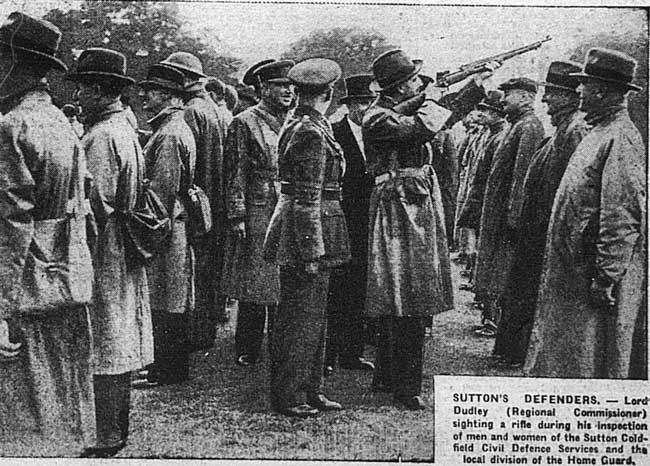
Acnowledgement to
Matt Felkin and his "Wartime
Birmingham and the Blitz" Facebook page.
**********
And in December 1940, and
possibly
on the same occasion, a mounted group: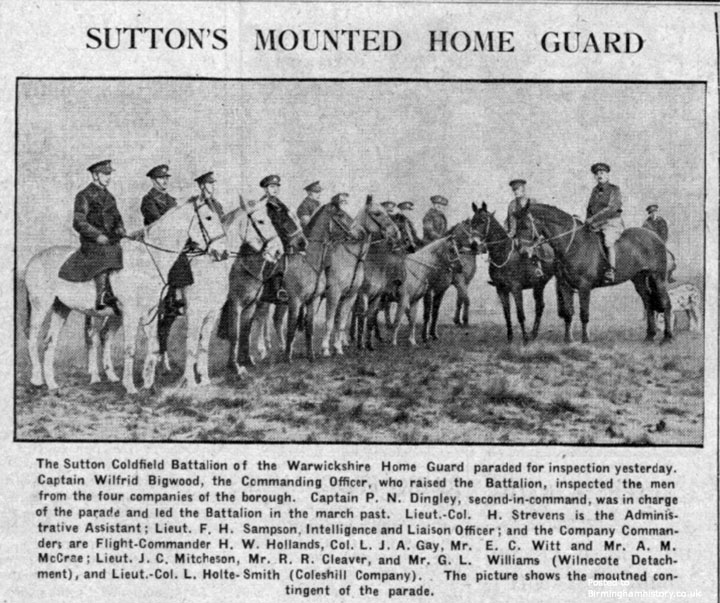 Acnowledgement
to Birmingham Mail Acnowledgement
to Birmingham Mail
A member of this mounted group was
Norman Wilkinson who lived in
Crayford Road, Kingstanding. Perhaps
he is included in the above photograph. In a wonderful memoir of his
early life, written in the 1990s and available to read in its entirety
here in the Birmingham History Forum, he says:
.......My working at Peacocks wasn't doing
much for my patriotic soul and l felt I wasn't doing enough for the
war effort. So at 15 l joined the L.D.V's (Local Defence Volunteers)
later to become the Home Guard. I was also a fire-watcher and later in
the year I became a volunteer A.F.S. Fireman. Around this time I tried
to join the Royal Navy but was told 'come back when you're old enough'
I was a true patriot........
........ I still had my duties in the Home
Guard to perform. However I transferred to the mounted divison
(horseback) and on duty nights we patrolled Sutton Park. We were the
only mounted division in the midlands (possibly the country) though
for me it wasn't all patriotism, it was a cheap way for horse riding
experience. At that time it was 8/- (40p) per half-hour to hire a
horse at Sutton Riding School (just
50 yards from Sutton Town Gate) and
this is where our HQ was. We were getting top class lessons from the
Major (ex-cavalry Sgt. Maj.) for nothing.....
(Grateful
acknowledgement to EmmaLL, member of BHF)
Added August 2020
**********
This is thought to be an image of a Sutton
group, perhaps a Section or small Platoon, but has yet to be confirmed
as such.
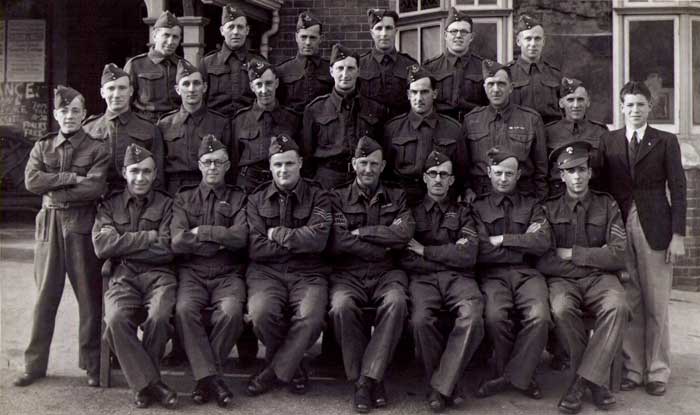
Acnowledgement to Graham Knight and to
Matt Felkin and his "Wartime
Birmingham and the Blitz" Facebook page.
**********
The Sutton Coldfield Volunteers, a defence force from an earlier era, were photographed in the town at some time during the Great War. Click on the title to see the image.
**********
In April 2005 there appeared and was sold on eBay an autograph album which appeared from the illustration to have been beautifully produced. It had been signed and presented to Lt. James Iveson by members of his No. 7 Platoon, "B" Coy., 6th Warwickshire (Sutton) Home Guard - a unit adjoining the 32nd (Aldridge) Battalion - in appreciation of his leadership on the occasion of his being transferred to become Commanding Officer of No. 6 Platoon in September 1941.
Webmaster….. 17th October 2005
******************************************************************
SUTTON COLDFIELD, BISHOP VESEY'S GRAMMAR SCHOOL
The late Mr. David Riggall, a chemistry master at Bishop Vesey's Grammar School prior to his transfer to essential war work on explosives, provided within his memoirs a glimpse of Civil Defence support duties in Sutton in 1940. This was originally published within the BBC People's War Archive.
"....In January 1940, I moved digs to no 3 Royal Road, Sutton Coldfield, recommended by Mr and Mrs de Jersey (distant relations) who thought I might be put up under better conditions than at 90 Victoria Road......."....On Sunday May 7th 1940, I had my first night at the Report Centre, from 6-11pm, and then two days later I was there from 11pm until 8.30am. Mr Hudspith, the French Master at Bishop Vesey’s, who often invited me to his house in Belwell Lane, had persuaded me to join this Civil Defence job at Sutton Council House. We had to man the telephones out of office hours, taking messages from organisations such as the Auxiliary Fire Service, the Home Guard (called the Local Defence Volunteers or ‘LDV’ at first), and the Rescue Services. We then passed them on as required. It was anticipated that enemy parachutists might be dropped to disrupt services and their location needed to be reported by the public and pin-pointed as soon as possible. If the telephones had broken down we would have had to go out and deliver the messages in person. In fact, we never had anything serious to deal with, only a few ‘suspicious circumstances’ reports and normal peace-time mishaps. We actually had a marvellous time, telling jokes and playing ‘solo’ for halfpennies. If nothing seemed to be happening by about 1 or 2am we unrolled the mattresses provided and went to sleep in the Council Chamber or elsewhere. We went in usually about 3 times a week, on various shifts. One preliminary requirement for this service was to attend a ‘Gas Course’ held at ‘Oakhurst’ in Anchorage Road. This was a series of lectures about the types of gas likely to be used, procedure etc and finished with a practical exercise of putting on a mask and going into a room full of gas (probably ‘tear’ gas).
At the end of November 1940, I changed my digs again, this time to ‘Leafield’ at 31 Clifton Road in Sutton........."
© David Ernest Riggall and family 2005 To read the rest of this article, entitled What did you do in the war Daddy ? (part 1) which includes other mentions of B.V.G.S.,
please click here. (You will leave this site. WW2 People's War is an online archive of wartime memories contributed by members of the public and gathered by the BBC. The complete archive can be found at www.bbc.co.uk/ww2peopleswar.)
**********
The title of David Riggall's memoir could equally have been adopted by the French master at Bishop Vesey's Grammar School who is briefly mentioned above, Mr. William Hudspith, had he ever written of his experiences. There was rather more to William Hudspith's wartime activities than could ever have been imagined by his colleagues and pupils. Click to read the remarkable story of this Sutton Coldfield Home Guard.
**********
It appears that the war had some effect on the academic performance of boys at Bishop Vesey's, or was at least a quotable excuse. In 1941, according to 'A History of Bishop Vesey's Grammar School - The Twentieth Century' by Kerry Osbourne, "thirteen out of twenty-nine boys from form 5M1 failed their School Certificate but the Headmaster explained that they 'were giving a good deal of time to Home Guard duties.'"
******************************************************************
UFTON
In Colin Birt in a Warwickshire village Home Guard, Mr. Birt remembers his Home Guard service:
"The Home Guard Company and Platoon HQ was at Southam. In Ufton our Section had a sergeant and 9 privates. We were all countrymen, not very good at drill, but all very good shots! Our routine was a parade one evening a week in Ufton Village Hall. Three of us carried out guard duty at Southam HQ overnight once a month. We were guarding the ammunition store, which was one room in a Public House. The rifles were P47 American 'lease lend'. Occasionally we had weekend manoevres, but by Sunday morning most of the privates had disappeared to milk the cows."
© Colin Birt and Warwickshire Libraries 2005 To read the memoir in its original setting, the BBC's excellent People's War Archive,
please click here. (You will leave this site. WW2 People's War is an online archive of wartime memories contributed by members of the public and gathered by the BBC. The complete archive can be found at www.bbc.co.uk/ww2peopleswar.)
******************************************************************
WARWICK (also covering parts of Leamington Spa)
Warwick, Leamington and adjoining areas were
defended by the 1st Warwickshire (Warwick)
Battalion. There are several pages of images and
information relating to this
Battalion and these are listed on the 1st Warks (Warwick) Battn.
SUMMARY PAGE which
provides links to all of them. They include pages in memory of Lt. Cecil Fullerton
(Pat Fullerton),
Arthur John Lockwood
and Cpl. Ernest Frederick Cushing
of Lillington.
*********
Memories of Warwick Home Guard by Mr. Bernard Grimes and Mr. Tom Leedle in Blackout Duties in Warwick. (You will leave this site).
***********
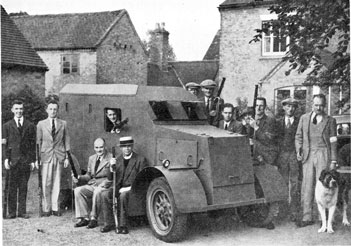 The
Marton Platoon had the distinction of possessing, as a result of
its own initiative, the first armoured vehicle within the entire Home
Guard. Its arrival even anticipated the issue of uniforms for the
men who were to operate it. It was apparently built by Councillor
Sam Myers and known as "The Trojan".
It thought to have been dismantled when the Home Guard was disbanded. An image of the vehicle is shown right. The
Marton Platoon had the distinction of possessing, as a result of
its own initiative, the first armoured vehicle within the entire Home
Guard. Its arrival even anticipated the issue of uniforms for the
men who were to operate it. It was apparently built by Councillor
Sam Myers and known as "The Trojan".
It thought to have been dismantled when the Home Guard was disbanded. An image of the vehicle is shown right.
The vicar of Marton, the Rev. A. Wilbraham
was a member of this Platoon. He had been an officer in the Great
War. He was initially a member of the ARP but soon joined the Home
Guard with the rank of Sergeant with a particular responsibility for
training in drill, musketry, map-reading and anti-gas measures in the
Marton Platoon,
No. 3 Platoon, "A" Company, 2nd Warwickshire
(Rugby) Battalion. He later became Company Training Officer
with the rank of Lieutenant. He is shown within this image, with
dog-collar and rifle.
Grateful acknowledgement is made to the
unknown source of the following information about this remarkable
vehicle:
Even in these early days No. 4 Platoon possessed
its very own armoured car. It is, indeed, the platoon's sole claim to
distinction that it possessed the first British L.D.V. armoured car.
Immediately upon the formation of the L.D.V. the platoon's
second-in-command contacted friends in Coventry in search of a chassis
suitable for conversion into some form of fighting vehicle, and the
scrap yards were combed (in vain) for iron sheeting. A number of
chassis were offered, but by far the most suitable was a Morris
Commercial lorry presented by the Parkside Garage Coy., and this was
taken over by Mr. Sam Myers, a well-known member of Coventry City
Council, The lorry was towed to Mr. Myers's works at Warwick, and, at
his very considerable expense, there fitted with a complete armoured
body, solidly welded, its front and sides punctuated with suitable
armoured embrazures for small arms and machine gun fire.
The
¼-inch armoured plate was thoroughly tested at Wedgnock, and was proof
against .303 at 100 yards. The vehicle was delivered and in commission
within three weeks of the formation of the L.D.V., (i.e. in June 1940)
and thereafter did Trojan work as an aid to training, while also
providing an invaluable means of transportation without which this
scattered unit would have been faced with many a quandary.
Its
early arrival is "dated" in the accompanying illustration by the fact
that it preceded denim, and then carried as its sole automatic weapon
a captured German tommy gun of the 1914-18 era, remarkably similar in
operation to the eventual Sten carbine, and using the same ammunition.
The German relic was replaced soon after by the first Lewis M.G.
issued to Battalion, and this was mounted to fire forwards through an
armoured embrazure.
Vivid were the dreams of its well-practiced
crew of the day when "the old tank" might rumble into the midst of
descending parachutists, its sides belching fire (at the rate of 10
rounds per man - dreams too often broken by the wail of
Coventry's sirens, when the old car was often "stood to" lest the
dream should be fulfilled after.
Acknowledgement also to David Morse and to the Coventry Telegraph.
***********
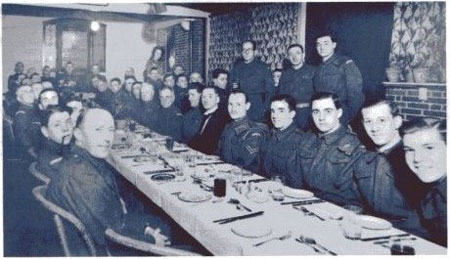
Convivial moments for members of the
1st Warwickshire Battalion
at the White Lion, Radford Semele,
possibly No. 4 Platoon.
Grateful acknowledgement to David Morse

***********
Mr. Ian Dellow remembers aspects of his father's Home Guard service in Warwick which will be familiar to many visitors to this site 'of a certain age':
"Prior to the start of the war, the government was eager to have the population ready in case of air raids, should war be declared. My father put himself forward as an ARP Warden, our house becoming a temporary warden’s post, mainly as a distribution centre for gas masks to the locals.
Later, as volunteers were called for the LDV (Local Defence Volunteers) my Dad left the ARP and, eventually, became a sergeant in the LDV, later known as the Home Guard.
It fell to my lot to keep his uniform and equipment in good order for his regular parades and exercises. This meant polishing leather gaiters and belt, cleaning rifle, bayonet and any brasses. He would put on his equipment and cycle off to his duty, the rifle slung under the cross bar of his bike. On one occasion, he was pulled up on parade for having his bayonet the wrong way round in it’s scabbard, this leading to me having a telling off as being responsible. Not that I got any pay for my war cleaning contribution.
Dad also had to put in an appearance at his works on occasions to do fire watching, his company having timber stores that were liable to take a liking to incendiary bombs."
© Ian Dellow 2003 To read Mr. Dellow's memoir in its original setting, the BBC's excellent People's War Archive,
please click here. (You will leave this site. WW2 People's War is an online archive of wartime memories contributed by members of the public and gathered by the BBC. The complete archive can be found at www.bbc.co.uk/ww2peopleswar.)
******************************************************************
WELLESBOURNE
An image of Wellesbourne Home Guard, 3rd December 1944 (the day of
stand-down).
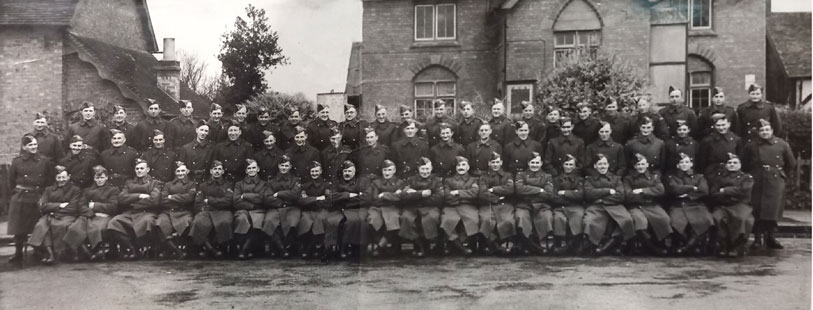 Bertie Jefferies,
back row, 10th from right. Bertie Jefferies,
back row, 10th from right.
(With grateful acknowledgement to
Bertie Jefferies's daughter-in-law, Mrs. Jefferies and to David Morse).
Recent addition!
|
**********
Two
commemorative badges for the
Warwickshire Home Guard - the
right-hand one with the more
successful depiction of the county
name!
(With
grateful acknowledgement to an
anonymous Warwickshire collector of
H.G. memorabilia)
|
 |
Contributions from visitors are warmly welcomed - and, please, an alert on any non-functioning link. Use FEEDBACK if you have material you would like to appear here.
Grateful acknowledgement for badge images to Stanley C. Jenkins
and A.N. Other.
|
SEARCH THIS PAGE
guidance |
|
|
Click on appropriate place name
shortcut
OR
-
for
most browsers on PCs,
laptops etc., press Ctrl+F and type in name
- for
Safari (iPad/iPhone), type
name in address bar; from drop-down list use
"On This Page"
-
for
Android devices, three
menu dots (top r.h. corner), then "Find on page"
|
|